- Privacy Policy

Home » APA Table of Contents – Format and Example

APA Table of Contents – Format and Example
Table of Contents

APA Table of Contents
The APA (American Psychological Association) Table of Contents is a structured outline that provides an overview of the content of a research paper or manuscript. It is typically included in the front matter of the document and lists the major sections and subsections of the paper, along with their page numbers. The Table of Contents is an important organizational tool that helps readers navigate the document and locate specific information quickly and easily.
How to Make APA Table of Contents
Here are the steps you can follow:
- Create a new page for the table of contents. The page number should be the Roman numeral “i”.
- Center the title “Table of Contents” at the top of the page.
- List all the headings and subheadings in your paper in order. Be sure to include all major sections and subsections.
- Align the page numbers to the right margin of the page.
- Use dot leaders to connect the headings to their respective page numbers. Dot leaders are a row of dots that help guide the reader’s eye from the heading to the page number.
I. Introduction ……………………………………………………… i
II. Literature Review ……………………………………………….. 1
A. Subheading ………………………………………………………… 2
B. Subheading ………………………………………………………… 3
III. Methodology ………………………………………………………….. 4
A. Participants ………………………………………………………… 5
B. Procedure …………………………………………………………… 6
IV. Results ……………………………………………………………………. 8
V. Discussion ……………………………………………………………… 10
VI. Conclusion …………………………………………………………….. 12
How to Make APA Table of Contents in MS Words
To create an APA table of contents in Microsoft Word, follow these steps:
- Start by typing out your document in Microsoft Word.
- Once you have finished typing your document, place your cursor at the beginning of your document.
- Click on the “References” tab in the top menu bar.
- Click on the “Table of Contents” option on the left-hand side of the menu bar.
- Choose one of the APA table of contents styles from the drop-down menu that appears. There are two options for an APA table of contents: “APA 6th Edition” and “APA 7th Edition.”
- Once you have chosen your preferred APA table of contents style, click on it to insert it into your document.
- Now you need to format your headings to be included in the table of contents. Select the heading you want to include in your table of contents.
- Click on the “Styles” option in the top menu bar.
- Choose the appropriate heading style from the drop-down menu that appears. You can choose from “Heading 1,” “Heading 2,” “Heading 3,” etc.
- Repeat the previous two steps for each heading you want to include in the table of contents.
- Once you have formatted all the headings, go back to the “References” tab in the top menu bar.
- Select the “Update Table” option from the drop-down menu that appears.
- Choose whether you want to update the page numbers only or the entire table of contents.
- Click “OK” to update your table of contents.
Your APA table of contents is now complete!
APA Table of Contents Format
Here’s the general format for creating a table of contents in APA style:
- Start a new page after the title page and abstract.
- Type “Table of Contents” at the top of the page, centered.
- List all the major sections of your paper, including the introduction, body, and conclusion.
- Indent each level of subheading, using either the tab key or your word processor’s formatting tools.
- Use the same font and size for the table of contents as you did for the rest of the paper.
- Align page numbers on the right side of the page, directly after each section and sub-section.
- Include any appendices and references in the table of contents, if applicable.
Here is an example of an APA-formatted table of contents:
Table of Contents Format
Introduction ………………………………………. 1
Literature Review ………………………………… 2
Methods ………………………………………….. 6
Participants ……………………………………. 6
Procedure ……………………………………….. 8
Results ………………………………………….. 10
Discussion ………………………………………. 15
Appendices ………………………………………. 20
References ………………………………………. 21
APA Table of Contents Example
Here is an example of an APA-style table of contents:
I. Introduction ……………………………………………………………………. 1
II. Literature Review …………………………………………………………….. 3
A. Background………………………………………………………………… 3
B. Theoretical Framework ………………………………………………… 5
C. Empirical Studies………………………………………………………… 7
III. Methodology …………………………………………………………………. 10
A. Research Design ………………………………………………………… 10
B. Participants ……………………………………………………………….. 11
C. Materials ………………………………………………………………….. 12 ‘
D. Procedure …………………………………………………………………. 14
IV. Results …………………………………………………………………………. 16
V. Discussion ……………………………………………………………………… 19
A. Summary of Findings …………………………………………………. 19
B. Implications ………………………………………………………………. 21
C. Limitations and Future Directions ………………………………… 23
VI. Conclusion ……………………………………………………………………. 25
VII. References …………………………………………………………………… 27
VIII. Appendices ………………………………………………………………….. 31
When to use APA Table of Contents
You should use an APA TOC when:
- You are writing a research paper or a thesis that is more than 5 pages in length.
- Your document has multiple headings and subheadings that require organization and clarification for the reader.
- You want to make it easy for readers to find specific sections or information within your document.
- You want to comply with the APA style guidelines for formatting and referencing.
- Your document contains complex information that requires a clear structure to make it more comprehensible for the reader.
Advantages of APA Table of Contents
The American Psychological Association (APA) style table of contents has several advantages, including:
- Easy navigation: A well-organized table of contents makes it easy for readers to find the information they need quickly and easily. This is especially important in longer documents such as academic papers, theses, and dissertations.
- Standardized formatting: The APA style table of contents follows a standardized formatting style that is familiar to many academic readers. This makes it easier for readers to understand the structure and organization of the document.
- Consistency : By using the APA style table of contents, authors can ensure that the document is consistent and follows a clear organizational structure. This can help readers to better understand the content and stay focused on the main points.
- Professional appearance : A well-formatted APA style table of contents can enhance the professional appearance of the document. This is particularly important in academic and research settings where a professional appearance can increase the credibility of the work.
- Compliance with academic standards : Many academic institutions require the use of the APA style for academic papers, theses, and dissertations. By using the APA style table of contents, authors can ensure that their work complies with these academic standards.
About the author
Muhammad Hassan
Researcher, Academic Writer, Web developer
You may also like

How to Cite Research Paper – All Formats and...

Data Collection – Methods Types and Examples

Delimitations in Research – Types, Examples and...

Research Paper Format – Types, Examples and...

Research Process – Steps, Examples and Tips

Research Design – Types, Methods and Examples
How to Write a Term Paper From Start to Finish

The term paper, often regarded as the culmination of a semester's hard work, is a rite of passage for students in pursuit of higher education. Here's an interesting fact to kick things off: Did you know that the term paper's origins can be traced back to ancient Greece, where scholars like Plato and Aristotle utilized written works to explore and document their philosophical musings? Just as these great minds once wrote their thoughts on parchment, you, too, can embark on this intellectual voyage with confidence and skill.
How to Write a Term Paper: Short Description
In this article, we'll delve into the core purpose of this kind of assignment – to showcase your understanding of a subject, your research abilities, and your capacity to communicate complex ideas effectively. But it doesn't stop there. We'll also guide you in the art of creating a well-structured term paper format, a roadmap that will not only keep you on track but also ensure your ideas flow seamlessly and logically. Packed with valuable tips on writing, organization, and time management, this resource promises to equip you with the tools needed to excel in your academic writing.
Understanding What Is a Term Paper
A term paper, a crucial component of your college education, is often assigned towards the conclusion of a semester. It's a vehicle through which educators gauge your comprehension of the course content. Imagine it as a bridge between what you've learned in class and your ability to apply that knowledge to real-world topics.
For instance, in a history course, you might be asked to delve into the causes and consequences of a significant historical event, such as World War II. In a psychology class, your term paper might explore the effects of stress on mental health, or in an environmental science course, you could analyze the impact of climate change on a specific region.
Writing a term paper isn't just about summarizing facts. It requires a blend of organization, deep research, and the art of presenting your findings in a way that's both clear and analytical. This means structuring your arguments logically, citing relevant sources, and critically evaluating the information you've gathered.
For further guidance, we've prepared an insightful guide for you authored by our expert essay writer . It's brimming with practical tips and valuable insights to help you stand out in this academic endeavor and earn the recognition you deserve.
How to Start a Term Paper
Before you start, keep the guidelines for the term paper format firmly in mind. If you have any doubts, don't hesitate to reach out to your instructor for clarification before you begin your research and writing process. And remember, procrastination is your worst enemy in this endeavor. If you're aiming to produce an exceptional piece and secure a top grade, it's essential to plan ahead and allocate dedicated time each day to work on it. Now, let our term paper writing services provide you with some valuable tips to help you on your journey:

- Hone Your Topic : Start by cultivating a learning mindset that empowers you to effectively organize your thoughts. Discover how to research a topic in the section below.
- Hook Your Readers: Initiate a brainstorming session and unleash a barrage of creative ideas to captivate your audience right from the outset. Pose intriguing questions, share compelling anecdotes, offer persuasive statistics, and more.
- Craft a Concise Thesis Statement Example : If you find yourself struggling to encapsulate the main idea of your paper in just a sentence or two, it's time to revisit your initial topic and consider narrowing it down.
- Understand Style Requirements: Your work must adhere to specific formatting guidelines. Delve into details about the APA format and other pertinent regulations in the section provided.
- Delve Deeper with Research : Equipped with a clearer understanding of your objectives, dive into your subject matter with a discerning eye. Ensure that you draw from reputable and reliable sources.
- Begin Writing: Don't obsess over perfection from the get-go. Just start writing, and don't worry about initial imperfections. You can always revise or remove those early sentences later. The key is to initiate the term papers as soon as you've amassed sufficient information.
Ace your term paper with EssayPro 's expert help. Our academic professionals are here to guide you through every step, ensuring your term paper is well-researched, structured, and written to the highest standards.

Term Paper Topics
Selecting the right topic for your term paper is a critical step, one that can significantly impact your overall experience and the quality of your work. While instructors sometimes provide specific topics, there are instances when you have the freedom to choose your own. To guide you on how to write a term paper, consider the following factors when deciding on your dissertation topics :

- Relevance to Assignment Length: Begin by considering the required length of your paper. Whether it's a substantial 10-page paper or a more concise 5-page one, understanding the word count will help you determine the appropriate scope for your subject. This will inform whether your topic should be broad or more narrowly focused.
- Availability of Resources : Investigate the resources at your disposal. Check your school or community library for books and materials that can support your research. Additionally, explore online sources to ensure you have access to a variety of reference materials.
- Complexity and Clarity : Ensure you can effectively explain your chosen topic, regardless of how complex it may seem. If you encounter areas that are challenging to grasp fully, don't hesitate to seek guidance from experts or your professor. Clarity and understanding are key to producing a well-structured term paper.
- Avoiding Overused Concepts : Refrain from choosing overly trendy or overused topics. Mainstream subjects often fail to captivate the interest of your readers or instructors, as they can lead to repetitive content. Instead, opt for a unique angle or approach that adds depth to your paper.
- Manageability and Passion : While passion can drive your choice of topic, it's important to ensure that it is manageable within the given time frame and with the available resources. If necessary, consider scaling down a topic that remains intriguing and motivating to you, ensuring it aligns with your course objectives and personal interests.
Worrying About the Quality of Your Upcoming Essay?
"Being highly trained professionals, our writers can provide term paper help by creating a paper specifically tailored to your needs.
Term Paper Outline
Before embarking on the journey of writing a term paper, it's crucial to establish a well-structured outline. Be mindful of any specific formatting requirements your teacher may have in mind, as these will guide your outline's structure. Here's a basic format to help you get started:
- Cover Page: Begin with a cover page featuring your name, course number, teacher's name, and the deadline date, centered at the top.
- Abstract: Craft a concise summary of your work that informs readers about your paper's topic, its significance, and the key points you'll explore.
- Introduction: Commence your term paper introduction with a clear and compelling statement of your chosen topic. Explain why it's relevant and outline your approach to addressing it.
- Body: This section serves as the meat of academic papers, where you present the primary findings from your research. Provide detailed information about the topic to enhance the reader's understanding. Ensure you incorporate various viewpoints on the issue and conduct a thorough analysis of your research.
- Results: Share the insights and conclusions that your research has led you to. Discuss any shifts in your perspective or understanding that have occurred during the course of your project.
- Discussion: Conclude your term paper with a comprehensive summary of the topic and your findings. You can wrap up with a thought-provoking question or encourage readers to explore the subject further through their own research.
How to Write a Term Paper with 5 Steps
Before you begin your term paper, it's crucial to understand what a term paper proposal entails. This proposal serves as your way to introduce and justify your chosen topic to your instructor, and it must gain approval before you start writing the actual paper.
In your proposal, include recent studies or research related to your topic, along with proper references. Clearly explain the topic's relevance to your course, outline your objectives, and organize your ideas effectively. This helps your instructor grasp your term paper's direction. If needed, you can also seek assistance from our expert writers and buy term paper .

Draft the Abstract
The abstract is a critical element while writing a term paper, and it plays a crucial role in piquing the reader's interest. To create a captivating abstract, consider these key points from our dissertation writing service :
- Conciseness: Keep it short and to the point, around 150-250 words. No need for lengthy explanations.
- Highlight Key Elements: Summarize the problem you're addressing, your research methods, and primary findings or conclusions. For instance, if your paper discusses the impact of social media on mental health, mention your research methods and significant findings.
- Engagement: Make your abstract engaging. Use language that draws readers in. For example, if your paper explores the effects of artificial intelligence on the job market, you might begin with a question like, 'Is AI revolutionizing our work landscape, or should we prepare for the robots to take over?'
- Clarity: Avoid excessive jargon or technical terms to ensure accessibility to a wider audience.
Craft the Introduction
The introduction sets the stage for your entire term paper and should engage readers from the outset. To craft an intriguing introduction, consider these tips:
- Hook Your Audience: Start with a captivating hook, such as a thought-provoking question or a compelling statistic. For example, if your paper explores the impact of smartphone addiction, you could begin with, 'Can you remember the last time you went a whole day without checking your phone?'
- State Your Purpose: Clearly state the purpose of your paper and its relevance. If your term paper is about renewable energy's role in combating climate change, explain why this topic is essential in today's world.
- Provide a Roadmap: Briefly outline how your paper is structured. For instance, if your paper discusses the benefits of mindfulness meditation, mention that you will explore its effects on stress reduction, emotional well-being, and cognitive performance.
- Thesis Statement: Conclude your introduction with a concise thesis statement that encapsulates the central argument or message of your paper. In the case of a term paper on the impact of online education, your thesis might be: 'Online education is revolutionizing learning by providing accessibility, flexibility, and innovative teaching methods.'
Develop the Body Sections: Brainstorming Concepts and Content
Generate ideas and compose text: body sections.
The body of your term paper is where you present your research, arguments, and analysis. To generate ideas and write engaging text in the body sections, consider these strategies from our research paper writer :
- Structure Your Ideas: Organize your paper into sections or paragraphs, each addressing a specific aspect of your topic. For example, if your term paper explores the impact of social media on interpersonal relationships, you might have sections on communication patterns, privacy concerns, and emotional well-being.
- Support with Evidence: Back up your arguments with credible evidence, such as data, research findings, or expert opinions. For instance, when discussing the effects of social media on mental health, you can include statistics on social media usage and its correlation with anxiety or depression.
- Offer Diverse Perspectives: Acknowledge and explore various viewpoints on the topic. When writing about the pros and cons of genetic engineering, present both the potential benefits, like disease prevention, and the ethical concerns associated with altering human genetics.
- Use Engaging Examples: Incorporate real-life examples to illustrate your points. If your paper discusses the consequences of climate change, share specific instances of extreme weather events or environmental degradation to make the topic relatable.
- Ask Thought-Provoking Questions: Integrate questions throughout your text to engage readers and stimulate critical thinking. In a term paper on the future of artificial intelligence, you might ask, 'How will AI impact job markets and the concept of work in the coming years?'
Formulate the Conclusion
The conclusion section should provide a satisfying wrap-up of your arguments and insights. To craft a compelling term paper example conclusion, follow these steps:
- Revisit Your Thesis: Begin by restating your thesis statement. This reinforces the central message of your paper. For example, if your thesis is about the importance of biodiversity conservation, reiterate that biodiversity is crucial for ecological balance and human well-being.
- Summarize Key Points: Briefly recap the main points you've discussed in the body of your paper. For instance, if you've been exploring the impact of globalization on local economies, summarize the effects on industries, job markets, and cultural diversity.
- Emphasize Your Main Argument: Reaffirm the significance of your thesis and the overall message of your paper. Discuss why your findings are important or relevant in a broader context. If your term paper discusses the advantages of renewable energy, underscore its potential to combat climate change and reduce our reliance on fossil fuels.
- Offer a Thoughtful Reflection: Share your own reflections or insights about the topic. How has your understanding evolved during your research? Have you uncovered any unexpected findings or implications? If your paper discusses the future of space exploration, consider what it means for humanity's quest to explore the cosmos.
- End with Impact: Conclude your term paper with a powerful closing statement. You can leave the reader with a thought-provoking question, a call to action, or a reflection on the broader implications of your topic. For instance, if your paper is about the ethics of artificial intelligence, you could finish by asking, 'As AI continues to advance, what ethical considerations will guide our choices and decisions?'
Edit and Enhance the Initial Draft
After completing your initial draft, the revision and polishing phase is essential for improving your paper. Here's how to refine your work efficiently:
- Take a Break: Step back and return to your paper with a fresh perspective.
- Structure Check: Ensure your paper flows logically and transitions smoothly from the introduction to the conclusion.
- Clarity and Conciseness: Trim excess words for clarity and precision.
- Grammar and Style: Proofread for errors and ensure consistent style.
- Citations and References: Double-check your citations and reference list.
- Peer Review: Seek feedback from peers or professors for valuable insights.
- Enhance Intro and Conclusion: Make your introduction and conclusion engaging and impactful.
- Coherence Check: Ensure your arguments support your thesis consistently.
- Read Aloud: Reading your paper aloud helps identify issues.
- Final Proofread: Perform a thorough proofread to catch any remaining errors.
Term Paper Format
When formatting your term paper, consider its length and the required citation style, which depends on your research topic. Proper referencing is crucial to avoid plagiarism in academic writing. Common citation styles include APA and MLA.
If unsure how to cite term paper for social sciences, use the APA format, including the author's name, book title, publication year, publisher, and location when citing a book.
For liberal arts and humanities, MLA is common, requiring the publication name, date, and location for referencing.
Adhering to the appropriate term paper format and citation style ensures an organized and academically sound paper. Follow your instructor's guidelines for a polished and successful paper.
Term Paper Example
To access our term paper example, simply click the button below.
The timeline of events from 1776 to 1861, that, in the end, prompted the American Civil War, describes and relates to a number of subjects modern historians acknowledge as the origins and causes of the Civil War. In fact, pre-Civil War events had both long-term and short-term influences on the War—such as the election of Abraham Lincoln as the American president in 1860 that led to the Fall of Fort Sumter in April of the same year. In that period, contentions that surrounded states’ rights progressively exploded in Congress—since they were the initial events that formed after independence. Congress focused on resolving significant issues that affected the states, which led to further issues. In that order, the US’s history from 1776 to 1861 provides a rich history, as politicians brought forth dissimilarities, dissections, and tensions between the Southern US & the people of slave states, and the Northern states that were loyal to the Union. The events that unfolded from the period of 1776 to 1861 involved a series of issues because they promoted the great sectional crisis that led to political divisions and the build-up to the Civil War that made the North and the South seem like distinctive and timeless regions that predated the crisis itself.
Final Thoughts
In closing, approach the task of writing term papers with determination and a positive outlook. Begin well in advance, maintain organization, and have faith in your capabilities. Don't hesitate to seek assistance if required, and express your individual perspective with confidence. You're more than capable of succeeding in this endeavor!
Need a Winning Hand in Academia?
Arm yourself with our custom-crafted academic papers that are sharper than a well-honed pencil! Order now and conquer your academic challenges with style!
What is the Difference between a Term Paper and a Research Paper?
What is the fastest way to write a term paper, related articles.
%20(1).webp)
- Link to facebook
- Link to linkedin
- Link to twitter
- Link to youtube
- Writing Tips
How to Structure the Table of Contents for a Research Paper

4-minute read
- 16th July 2023
So you’ve made it to the important step of writing the table of contents for your paper. Congratulations on making it this far! Whether you’re writing a research paper or a dissertation , the table of contents not only provides the reader with guidance on where to find the sections of your paper, but it also signals that a quality piece of research is to follow. Here, we will provide detailed instructions on how to structure the table of contents for your research paper.
Steps to Create a Table of Contents
- Insert the table of contents after the title page.
Within the structure of your research paper , you should place the table of contents after the title page but before the introduction or the beginning of the content. If your research paper includes an abstract or an acknowledgements section , place the table of contents after it.
- List all the paper’s sections and subsections in chronological order.
Depending on the complexity of your paper, this list will include chapters (first-level headings), chapter sections (second-level headings), and perhaps subsections (third-level headings). If you have a chapter outline , it will come in handy during this step. You should include the bibliography and all appendices in your table of contents. If you have more than a few charts and figures (more often the case in a dissertation than in a research paper), you should add them to a separate list of charts and figures that immediately follows the table of contents. (Check out our FAQs below for additional guidance on items that should not be in your table of contents.)
- Paginate each section.
Label each section and subsection with the page number it begins on. Be sure to do a check after you’ve made your final edits to ensure that you don’t need to update the page numbers.
- Format your table of contents.
The way you format your table of contents will depend on the style guide you use for the rest of your paper. For example, there are table of contents formatting guidelines for Turabian/Chicago and MLA styles, and although the APA recommends checking with your instructor for formatting instructions (always a good rule of thumb), you can also create a table of contents for a research paper that follows APA style .
- Add hyperlinks if you like.
Depending on the word processing software you’re using, you may also be able to hyperlink the sections of your table of contents for easier navigation through your paper. (Instructions for this feature are available for both Microsoft Word and Google Docs .)
To summarize, the following steps will help you create a clear and concise table of contents to guide readers through your research paper:
1. Insert the table of contents after the title page.
2. List all the sections and subsections in chronological order.
3. Paginate each section.
4. Format the table of contents according to your style guide.
5. Add optional hyperlinks.
If you’d like help formatting and proofreading your research paper , check out some of our services. You can even submit a sample for free . Best of luck writing your research paper table of contents!
What is a table of contents?
A table of contents is a listing of each section of a document in chronological order, accompanied by the page number where the section begins. A table of contents gives the reader an overview of the contents of a document, as well as providing guidance on where to find each section.
Find this useful?
Subscribe to our newsletter and get writing tips from our editors straight to your inbox.
What should I include in my table of contents?
If your paper contains any of the following sections, they should be included in your table of contents:
● Chapters, chapter sections, and subsections
● Introduction
● Conclusion
● Appendices
● Bibliography
Although recommendations may differ among institutions, you generally should not include the following in your table of contents:
● Title page
● Abstract
● Acknowledgements
● Forward or preface
If you have several charts, figures, or tables, consider creating a separate list for them that will immediately follow the table of contents. Also, you don’t need to include the table of contents itself in your table of contents.
Is there more than one way to format a table of contents?
Yes! In addition to following any recommendations from your instructor or institution, you should follow the stipulations of your style guide .
Share this article:
Post A New Comment
Got content that needs a quick turnaround? Let us polish your work. Explore our editorial business services.
3-minute read
How to Insert a Text Box in a Google Doc
Google Docs is a powerful collaborative tool, and mastering its features can significantly enhance your...
2-minute read
How to Cite the CDC in APA
If you’re writing about health issues, you might need to reference the Centers for Disease...
5-minute read
Six Product Description Generator Tools for Your Product Copy
Introduction If you’re involved with ecommerce, you’re likely familiar with the often painstaking process of...
What Is a Content Editor?
Are you interested in learning more about the role of a content editor and the...
The Benefits of Using an Online Proofreading Service
Proofreading is important to ensure your writing is clear and concise for your readers. Whether...
6 Online AI Presentation Maker Tools
Creating presentations can be time-consuming and frustrating. Trying to construct a visually appealing and informative...

Make sure your writing is the best it can be with our expert English proofreading and editing.
How To Write a Term Paper: A Guide That Works
30 June, 2020
16 minutes read
Author: Mathieu Johnson
Once you’ve started your university career, you are going to be asked to present a term paper. What’s the difference between a term paper and a research paper? How can you write a good term? What’s the best way to structure it? Where can you find some tips to make the writing process faster? In this article, we’ll discuss a few tips to help you prepare a term paper quickly and professionally.

What Is a Term Paper… And What Is The First Step?
A term paper is a critical and analytical report on the topic or subject that you covered within the course of studies. It usually consists of two separate but equally important aspects: your own thoughts about the topic and a demonstration of your understanding of the existing literature. The main goal of this assignment is to summarize the material you learned and showcase your understanding of the topic. This aspect makes the term paper a universal instrument for assessing a student’s proficiency. It also explains why term papers cost so many points of your course grade.
We usually associate a term paper with a research paper , but although the concepts are quite similar, a research paper requires a more academic approach and a deeper investigation into the literature of your field of study.
To write an outstanding college term paper, you must understand that your professor has requested it in order to test your analytical thinking skills. You must collect relevant data, analyze it, and then make a summary or solve a particular problem. Such skills are highly relevant to the business world, so this type of the task is as practical as it is educational.
So, let’s start the preparation!
Before you begin writing

Unfortunately, there is no magical recipe that allows you to get everything done fast. You will need to choose the best way forward in whatever situation you find yourself, but here are some tips to help you prepare for the assignment.
To begin with, take the research stage seriously . Sometimes, when students are really interested in a topic, they only want to present their personal ideas about the problem. Unfortunately, if you’re not completely familiar with all the data from the various sources, you will need to reinvent the bicycle.
Term paper writing was never an easy ride. Well, not for our expert writers. Place an order with our term paper writing service and secure yourself an “A!”
In the initial stages of your research, investigate everything you can find on the topic . This may sound like a tall order, but you’ll find that it doesn’t actually entail that much reading. At this point you are only compiling the research, so you will be skimming through numerous prospects rather than reading them completely. Bear in mind that your aim is to get acquainted with the various aspects of your problem. The term paper summarizes the knowledge you gained within a course and requires to familiarize yourself with the research that other people have already made on your topic.
Thinking that your opinions are completely original and unique is quite egocentric, and it can get you into trouble. So, “your” thoughts about the problem are usually just somebody else’s statements that you have rephrased (or even a well-established academic concept!). Remember that your professor will be familiar with all the literature surrounding the issue: if you merely rewrite someone else’s thoughts and present them as your own (even if you don’t realize doing it), be prepared for criticism!
Applying a Structure To Your Term Paper

Once you have read all the leading authors and their approaches to your problem, it’s time to create a structure for your work. This is not yet an outline; you just need to decide what to write about. Sketch out the topic for the theoretical portion of your work and think about practical aspects and how you can approach the research in the best possible way.
At this point, you really need to call or email your supervisor . Your professor will have seen hundreds of term papers like yours (i.e., they have not yet been written, but a definite idea exists!) and will be prepared to give you feedback and advice. He or she will tell you what literature you have omitted, offer suggestions about what you should read, and give you feedback about your paper. It may well be that your approach has already occurred to somebody else, in which case there is no need to repeat it.
Choosing a Topic: Easy as Riding a Bike?
When you choose your topic, make sure you choose something that you are interested in . That’s our advice if you want a painless term paper. If you prefer to investigate a field that you’ve never really explored before, you can challenge yourself to do that, too. That might be sophisticated, but why not?
If you decide to investigate a topic or a problem that you are pretty familiar with, your writing will be more fluid. You will focus your attention on a specific aspect of the chosen field and expand your knowledge within that scope. On the contrary, choosing an unfamiliar subject matter can wash out your expertise.
Be prepared to change the topic if you find out that your research isn’t going anywhere. It might occur that you presuppose that your topic has a potential but somewhere at the stage of initial research, you find that it just won’t work. It’s always a good idea to consider two or three topics when you kick off the term paper writing – even if they are just different ways of examining the same problem. By doing this, you will be able to choose the best version, which may not be the one you started with at all!
Related Post: 100 Persuasive essay topics
Formulating a Thesis statement

Writing a proper thesis statement can also be challenging. To begin with, write down a couple of prominent ideas or concepts, then try to make rough drafts of them to see how they’ll work in the structural framework. You will probably find that one idea fits your style, interests, and knowledge base: you can choose that one as your thesis statement.
Remember that the thesis statement is the skeleton, the central concept of your paper. It is the elemental attribute of almost any academic paper – from master’s thesis to a simple five paragraph essay. If you do a thorough job on it, you will find that writing (and defending!) your argument is much easier.
Be aware that all of these stages are parts of a procedure – one leads to another. When writing a term paper, you should collect the material and wrap it up at the same time.
Planning – The Key To Success
Some people claim that they can write a term paper without any planning. In our opinion, this is impossible. If you don’t have a postgraduate degree and you aren’t a certified genius, you need to prepare an outline for your project. It may come as a surprise, but even people who claim otherwise actually prepare outlines – in their heads. But if you don’t have that much experience, use a pencil and your notebook to ensure that you don’t forget anything.
Don’t procrastinate on your College or University papers anymore. Get professional help with our essay writer !
That’s when we get to preparing your first draft . There’s only one thing to add here: do as many drafts as you need in order to achieve your goal. Understand that your aim is to create an excellent term paper and keep working at it until you are satisfied.
Term Paper Outline: Write Everything In The Proper Section!

In the Introduction , state the topic that you are going to investigate and the context of your work. This is the critical ‘selling’ moment of your work. In a nutshell, your introduction combined with a conclusion should give a sneak peek into what the whole paper is about. If your introduction is well-prepared, it will be quite complacent about the body of your project. The introduction must include an abstract that presents your thesis statement . You should explain your motivation (why should the reader be concerned about this problem?) , your methods (what scientific tools did you use?) , and the results (what you achieved) .
The Literature Review totally corresponds to its name – it is here to review the literature you compiled. Your professor will double check it to make sure that you understand the context of your argument. One more thing to add is: collect all the information you can! Ideally, you should read or at least glance through every book and author that you can find on the topic. Think of your task as a fascinating journey: if you approach it like that, reading hundreds of pages won’t seem like that much of a challenge.
In the Discussion , you must present the interpretations of the problem. Be honest, explain what you pieces of data you don’t agree with and what ideas and concepts you support. This section connects the dots between theory and practice when writing a term paper. Wherever possible, provide several interpretations of the subject matter, then choose the one(s) that are most relevant to the case you are presenting.
In the Body , focus on those arguments that prove your thesis statement. This section must be absolutely logical. If you have chosen a more complicated topic, use heading and sub-headings to improve the appearance of this section. While writing the body, keep your target audience (your professors) in mind. In other words, don’t just record the obvious causes/effects/solutions but also showcase your own findings – what you have discovered and how that proves your thesis statement. Demonstrate that you are familiar with the details and you will stun your readers with the prolific mastery of the topic.
Now, the Conclusion is her to summarize both the content and the purpose of the paper. The most challenging part is not to make it too dry. Reiterate your thesis statement and briefly show how your results justified your proposition. At the very end, you can suggest a call to action or pose a rhetorical question or statement that leaves your reader wanting more.
What to do next?
When you have finished, reread your work a couple of times. You will almost certainly find a few faults, whether they are contextual, factual, syntactical, grammatical, or even simple spelling mistakes. A very useful tip is to wait for two or three days after writing your final draft to proofread it afterward. Your brain will have time to process the information, and you’ll be able to look at it with a fresh view.

When proofreading, take care to polish the structural problems. The skeleton (the logic and the thesis statement) should make sense. If they don’t, try to approach the problem from another perspective. The changes may take some time, but bear in mind that your objective is to produce professional work. Be patient!
After that, print the term paper. The human eye processes information differently on the paper than on a computer screen; that’s why you need to print it and take one final look for any possible mistakes. Even if you don’t see any serious defects, pay attention to formatting, punctuation, and synonyms. It’s an academic text, so make it shine!
Term Paper Sample
Be sure to check the sample of a term paper, completed by our writers. Use it as an example to perfect your own writing. Link: Term Paper Sample: Consumer Buying Behavior .
The Do’s and Don’ts of Term Paper Writing
There you have the most important tips to help you succeed in writing a term paper. Now it’s up to you to stop reading and start writing!


A life lesson in Romeo and Juliet taught by death
Due to human nature, we draw conclusions only when life gives us a lesson since the experience of others is not so effective and powerful. Therefore, when analyzing and sorting out common problems we face, we may trace a parallel with well-known book characters or real historical figures. Moreover, we often compare our situations with […]

Ethical Research Paper Topics
Writing a research paper on ethics is not an easy task, especially if you do not possess excellent writing skills and do not like to contemplate controversial questions. But an ethics course is obligatory in all higher education institutions, and students have to look for a way out and be creative. When you find an […]

Art Research Paper Topics
Students obtaining degrees in fine art and art & design programs most commonly need to write a paper on art topics. However, this subject is becoming more popular in educational institutions for expanding students’ horizons. Thus, both groups of receivers of education: those who are into arts and those who only get acquainted with art […]
How to Write a Table of Contents for Different Formats With Examples
11 December 2023
last updated
Rules that guide academic writing are specific to each paper format. However, some rules apply to all styles – APA, MLA, Chicago/Turabian, and Harvard. Basically, one of these rules is the inclusion of a Table of Contents (TOC) in an academic text, particularly long ones, like theses, dissertations, and research papers. When writing a TOC, students or researchers should observe some practices regardless of paper formats. Also, it includes writing the TOC on a new page after the title page, numbering the first-level and corresponding second-level headings, and indicating the page number of each entry. Hence, scholars need to learn how to write a table of contents in APA, MLA, Chicago/Turabian, and Harvard styles.
General Guidelines
When writing academic texts, such as theses, dissertations, and other research papers, students observe academic writing rules as applicable. Generally, the different paper formats – APA, MLA, Chicago/Turabian, and Harvard – have specific standards that students must follow in their writing. In this case, one of the rules is the inclusion of a Table of Contents (TOC) in the document. By definition, a TOC is a roadmap that scholars provide in their writing, outlining each portion of a paper. In other words, a TOC enables readers to locate specific information in documents or revisit favorite parts within written texts. Moreover, this part of academic papers provides readers with a preview of the paper’s contents.
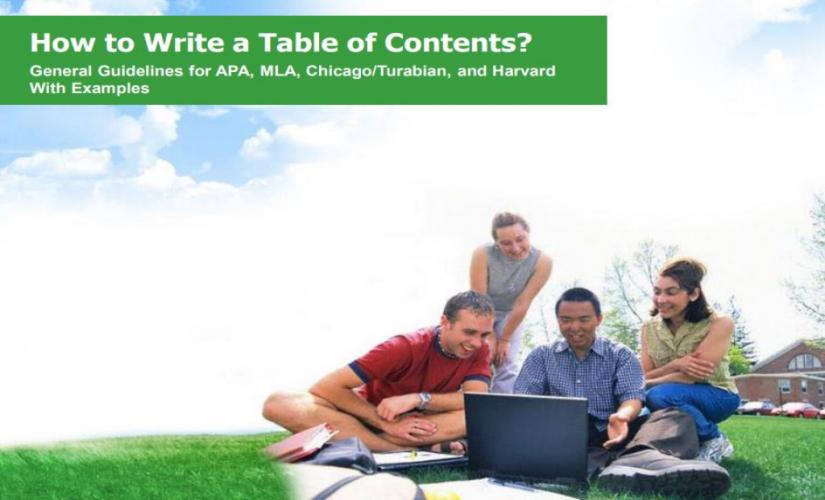
For writing your paper, these links will be helpful:
- Buy Research Paper
- How to Write a Research Paper
- How to Write a Research Proposal
- How to Write a Term Paper
- How to Write a Case Study
Difference Between a Table of Contents and an Outline
In essence, a TOC is a description of first-level headings (topics) and second-level headings (subtopics) within the paper’s body. For a longer document, writers may also include third-level titles to make the text palatable to read. Ideally, the length of papers determines the depth that authors go into detailing their writing in TOCs. Basically, this feature means that shorter texts may not require third-level headings. In contrast, an essay outline is a summary of the paper’s main ideas with a hierarchical or logical structuring of the content. Unlike a TOC that only lists headings and subheadings, outlines capture these headings and then describe the content briefly under each one. As such, an outline provides a more in-depth summary of essay papers compared to a TOC.
How to Write a Table of Contents in APA
When writing a TOC in the APA format , writers should capture all the headings in the paper – first-level, second-level, and even third-level. Besides this information, they should also include an abstract, references, and appendices. Notably, while a TOC in the APA style has an abstract, this section is not necessary for the other formats, like MLA, Chicago/Turabian, and Harvard. Hence, an example of a Table of Contents written in the APA format is indicated below:
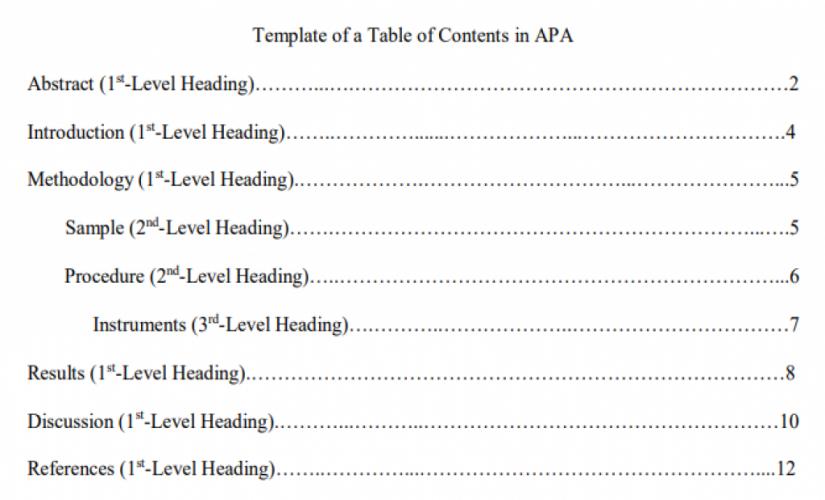
How to Write a Table of Contents in MLA
Unlike papers written in the APA style, MLA papers do not require a Table of Contents unless they are long enough. In this case, documents, like theses, dissertations, and books written in the MLA format should have a TOC. Even where a TOC is necessary, there is no specific method that a writer should use when writing it. In turn, the structure of the TOC is left to the writer’s discretion. However, when students have to include a TOC in their papers, the information they capture should be much more than what would appear in the APA paper . Hence, an example of writing a Table of Contents in MLA format is:
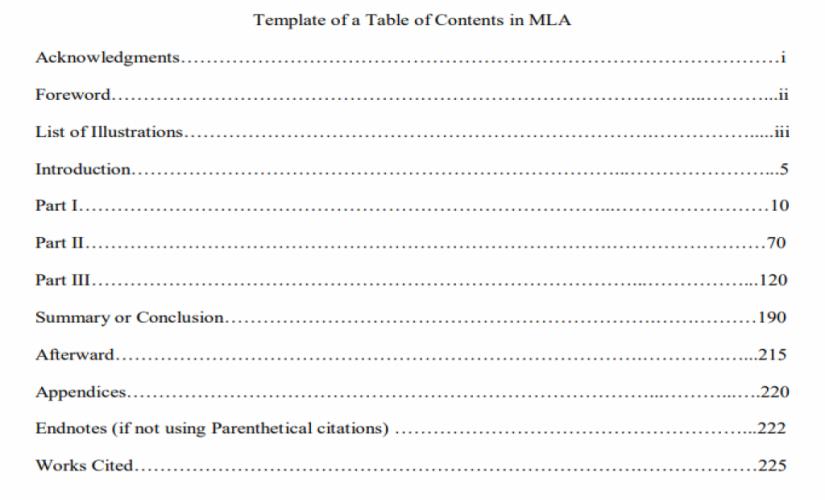
In the case of writing a research paper, an example of a Table of Contents should be:
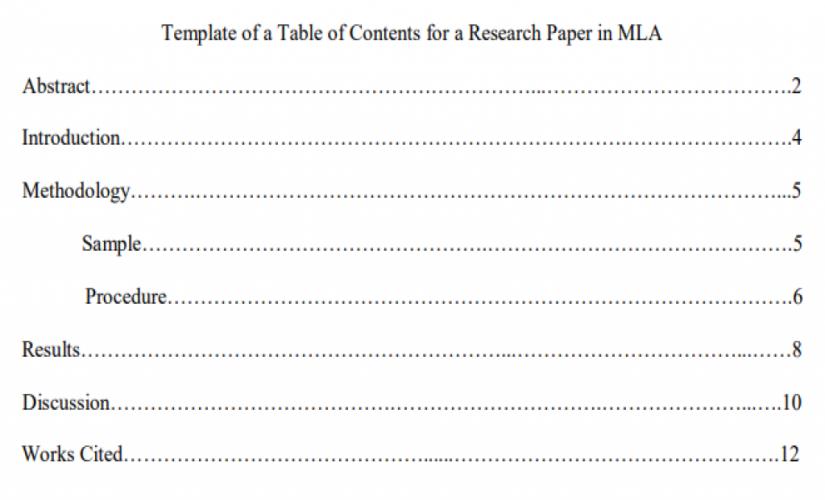
How to Write a Table of Contents in Chicago/Turabian
Like the MLA style, a Chicago/Turabian paper does not require writing a Table of Contents unless it is long enough. When a TOC is necessary, writers should capitalize on major headings. Additionally, authors do not need to add a row of periods (. . . . . . . .) between the heading entry and the page number. Moreover, the arrangement of the content should start with the first-level heading, then the second-level heading, and, finally, the third-level title, just like in the APA paper. In turn, all the information that precedes the introduction part should have lowercase Roman numerals. Also, the row of periods is only used for major headings. Hence, an example of writing a Table of Contents in a Chicago/Turabian paper is:
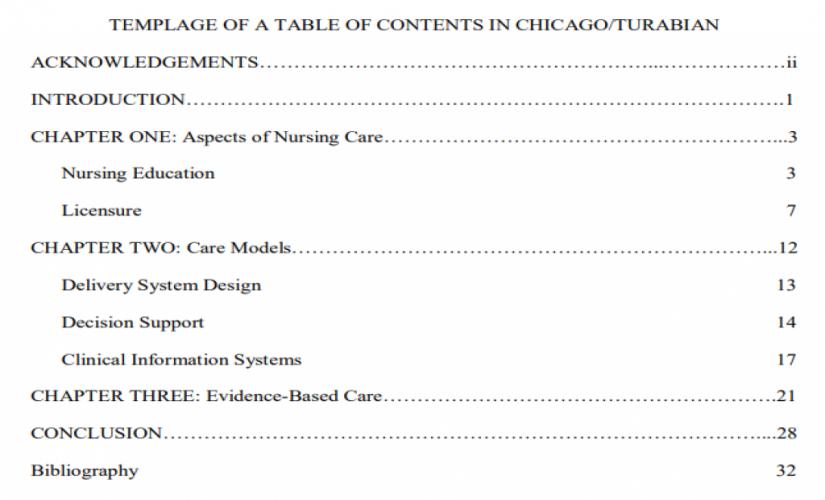
How to Write a Table of Contents in Harvard
Like in the other formats, writing a Table of Contents in the Harvard style is captured by having the title “Table of Contents” at the center of the page, in the first line. Basically, it comes after the title page and captures all the sections and subsections of Harvard papers. In other words, writers must indicate first-level headings in a numbered list. Also, scholars should align titles to the left side and capitalize them. In turn, if there is a need to show second-level headings, authors should list them under corresponding first-level headings by using bullet points. However, it is essential for students not to disrupt the numbering of first-level headings. Moreover, writers should align second-level headings to the left side and indent them by half an inch and capitalize on this content. Hence, an example of writing a Table of Contents in a Harvard paper should appear as below:
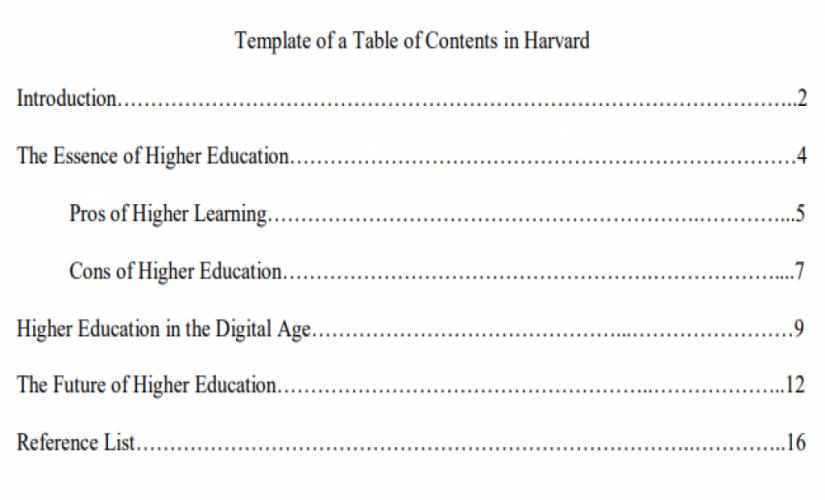
A Table of Content (TOC) is an essential component of an academic paper , particularly for long documents, like theses, dissertations, and research papers. When students are writing a TOC, they should be careful to follow the applicable format’s rules and standards. Regardless of the format, writers should master the following tips when writing a TOC:
- Write the TOC on a new page after the title page.
- Indicate first-level headings of the document in a numbered list.
- Indicate second-level headings under the corresponding first-level heading.
- If applicable, indicate third-level headings under the corresponding second-level heading.
- Write the page number for each heading.
- Put the content in a two-column table.
- Title the page with “Table of Contents.”
To Learn More, Read Relevant Articles
Mit essay prompts: free examples of writing assignments in 2024, how to cite a dictionary in mla 9: guidelines and examples.
- PRO Courses Guides New Tech Help Pro Expert Videos About wikiHow Pro Upgrade Sign In
- EDIT Edit this Article
- EXPLORE Tech Help Pro About Us Random Article Quizzes Request a New Article Community Dashboard This Or That Game Popular Categories Arts and Entertainment Artwork Books Movies Computers and Electronics Computers Phone Skills Technology Hacks Health Men's Health Mental Health Women's Health Relationships Dating Love Relationship Issues Hobbies and Crafts Crafts Drawing Games Education & Communication Communication Skills Personal Development Studying Personal Care and Style Fashion Hair Care Personal Hygiene Youth Personal Care School Stuff Dating All Categories Arts and Entertainment Finance and Business Home and Garden Relationship Quizzes Cars & Other Vehicles Food and Entertaining Personal Care and Style Sports and Fitness Computers and Electronics Health Pets and Animals Travel Education & Communication Hobbies and Crafts Philosophy and Religion Work World Family Life Holidays and Traditions Relationships Youth
- Browse Articles
- Learn Something New
- Quizzes Hot
- This Or That Game
- Train Your Brain
- Explore More
- Support wikiHow
- About wikiHow
- Log in / Sign up
- Education and Communications
- Technical Writing
How to Write a Table of Contents
Last Updated: February 16, 2024 Fact Checked
This article was co-authored by Stephanie Wong Ken, MFA . Stephanie Wong Ken is a writer based in Canada. Stephanie's writing has appeared in Joyland, Catapult, Pithead Chapel, Cosmonaut's Avenue, and other publications. She holds an MFA in Fiction and Creative Writing from Portland State University. This article has been fact-checked, ensuring the accuracy of any cited facts and confirming the authority of its sources. This article has been viewed 1,046,684 times.
The Table of Contents in a document acts as a map for the reader, making it easier for them to find information in the document based on title and page number. A good Table of Contents should be organized, easy to read and simple to use. You can write a Table of Contents manually on your computer or have a word processing tool create it for you. Make sure the Table of Contents is formatted properly in your final document so it is as accurate and accessible as possible.
Sample Tables of Contents

Creating the Table of Contents on a Word Processor

- The Table of Contents should be on its own page. Do not include the introduction or a dedication on the same page as the Table of Contents.

- For example, you may write down main headings like, “Introduction,” “Case Study 1,” or “Conclusion.”

- For example, under the main heading “Introduction” you may write the subheading, “Themes and Concepts.” Or under the main heading “Conclusion” you may write, “Final Analysis.”
- You can also include sub-subheadings underneath the subheadings, if applicable. For example, under the subheading “Themes and Concepts” you may have the sub-subheading, “Identity.”
- Some papers do not have subheadings at all, only main headings. If this is the case, skip this step.

- For example, if the “Introduction” section begins on page 1, you will attach “page 1” to the Introduction heading. If the “Conclusion” section begins on page 45, attach “page 45” to the Conclusion heading.

- Check that the subheadings are located underneath the correct headings, indented to the right.
- Make sure there are page numbers for the subheadings listed as well.
- You can center the content in the table using the table options if you want the content to appear a few spaces away from the lines of the table. You can also leave the content indented to the left if you'd prefer.

- You can put the title above the table or in a separate row on the top of the rest of the content.
Using a Word Processing Tool

- You should also confirm the page numbers are correct in the document. Each page should be numbered in order. Having the correct page numbers will ensure the Table of Contents is created correctly when you use the word processing tool.

- If there are subheadings in your document, label them “Heading 2.” Highlight each subheading and click on “Heading 2” in the Styles tab.
- If there are sub-subheadings in your document, label them “Heading 3.” Highlight each subheading and click on “Heading 3” in the Styles tab.
- The text and font for each main heading may change based on the settings for “Heading 1,” “Heading 2,” and “Heading 3.” You can choose your preferred text and font for each main heading so they appear as you like in the Table of Contents.

- You can choose the built-in Table of Content options, where the tool will automatically choose a font size and style for you.
- You can also go for from a list of custom Table of Contents, where you choose the font color and size based on your preferences.
Polishing the Table of Contents

- You should also check the subheadings or sub-subheadings in the Table of Contents, if applicable, to ensure they match those in the document.

- If you created the Table of Contents manually, do this by going in and adjusting the headings and/or the page numbers when they change.
- If you created the Table of Contents with a word processing tool, update it by clicking the Update option by the Table of Contents option on the Reference tab. You can side clicking on the Table of Contents and choosing “update” that way.
Community Q&A
You Might Also Like

- ↑ https://edu.gcfglobal.org/en/word-tips/how-to-create-a-table-of-contents-in-word/1/#
- ↑ https://examples.yourdictionary.com/reference/examples/table-of-content-examples.html
- ↑ http://bitesizebio.com/21549/using-word-to-write-your-thesis-making-a-table-of-contents-inserting-captions-and-cross-referencing/
- ↑ https://guides.lib.umich.edu/c.php?g=283073&p=1886010
- ↑ https://nsufl.libguides.com/c.php?g=413851&p=2820026
About This Article

To write a table of contents, open a new document and list the major headings, titles, or chapters of the project in chronological order. Next, insert subheadings or subtopics if your project has those. Fill in the page number where each heading starts, then format the content in a table with 2 columns. Place the headings and subheadings in order in the first column, then put the page numbers in the second column. Don't forget to add a "Table of Contents" title at the top of the document! To learn more about polishing your Table of Contents, read on! Did this summary help you? Yes No
- Send fan mail to authors
Reader Success Stories
Mar 22, 2017
Did this article help you?

Mar 3, 2022
Feb 1, 2018

Featured Articles

Trending Articles

Watch Articles

- Terms of Use
- Privacy Policy
- Do Not Sell or Share My Info
- Not Selling Info
Don’t miss out! Sign up for
wikiHow’s newsletter

The Plagiarism Checker Online For Your Academic Work
Start Plagiarism Check
Editing & Proofreading for Your Research Paper
Get it proofread now
Online Printing & Binding with Free Express Delivery
Configure binding now
- Academic essay overview
- The writing process
- Structuring academic essays
- Types of academic essays
- Academic writing overview
- Sentence structure
- Academic writing process
- Improving your academic writing
- Titles and headings
- APA style overview
- APA citation & referencing
- APA structure & sections
- Citation & referencing
- Structure and sections
- APA examples overview
- Commonly used citations
- Other examples
- British English vs. American English
- Chicago style overview
- Chicago citation & referencing
- Chicago structure & sections
- Chicago style examples
- Citing sources overview
- Citation format
- Citation examples
- College essay overview
- Application
- How to write a college essay
- Types of college essays
- Commonly confused words
- Definitions
- Dissertation overview
- Dissertation structure & sections
- Dissertation writing process
- Graduate school overview
- Application & admission
- Study abroad
- Master degree
- Harvard referencing overview
- Language rules overview
- Grammatical rules & structures
- Parts of speech
- Punctuation
- Methodology overview
- Analyzing data
- Experiments
- Observations
- Inductive vs. Deductive
- Qualitative vs. Quantitative
- Types of validity
- Types of reliability
- Sampling methods
- Theories & Concepts
- Types of research studies
- Types of variables
- MLA style overview
- MLA examples
- MLA citation & referencing
- MLA structure & sections
- Plagiarism overview
- Plagiarism checker
- Types of plagiarism
- Printing production overview
- Research bias overview
- Types of research bias
- Example sections
- Types of research papers
- Research process overview
- Problem statement
- Research proposal
- Research topic
- Statistics overview
- Levels of measurment
- Frequency distribution
- Measures of central tendency
- Measures of variability
- Hypothesis testing
- Parameters & test statistics
- Types of distributions
- Correlation
- Effect size
- Hypothesis testing assumptions
- Types of ANOVAs
- Types of chi-square
- Statistical data
- Statistical models
- Spelling mistakes
- Tips overview
- Academic writing tips
- Dissertation tips
- Sources tips
- Working with sources overview
- Evaluating sources
- Finding sources
- Including sources
- Types of sources
Your Step to Success
Plagiarism Check within 10min
Printing & Binding with 3D Live Preview
Example for Table of Contents
How do you like this article cancel reply.
Save my name, email, and website in this browser for the next time I comment.

Inhaltsverzeichnis
- 1 Definition
- 3 Examples for Your Thesis
- 4 Master’s Thesis Examples
- 5 Microsoft Word Tutorial
- 6 In a Nutshell
Definition
A table of contents example will help structure a long academic manuscript and a table of contents page is necessary for academic submission. The table of contents contains an organised listing of your manuscript’s chapters and sections with clearly marked (and accurate) page numbers. The aim of the table of contents is to allow the reader to flip easily to the section they require and to get a feel of your argument’s structure.
What comes first, table of contents or abstract?
If you are writing an academic paper, you have to take the order of your paper into account. Usually, the first sections of your thesis are the title page, cover page, acknowledgements and the abstract . After these pages, you place the table of contents. Be sure to check that all of the page numbers in your table of contents are correct.
What variations of table of content examples exist?
The table of contents can be displayed in the following formats:
- Single level table of contents
- Subdivided table of contents
- Multi-level table of contents
- Academic table of contents
You will find further details about what needs to be included inside of the table of contents on our blog.
Are references included in table of contents?
Yes. The references are included in the table of contents. You add them in as you would any other section of your thesis. Simply write the section in the table of contents with the corresponding page number. However, the acknowledgement for thesis and the abstract are usually not included in the table of contents. However, check with your institution as this could be dependent upon the formatting that you’re required to follow.
How can I make a table of contents in Microsoft Word?
On Microsoft Word, you will find the function to create a table of contents under the ‘references’ tab. Click on the tab and select ‘table of contents’. You can use one that has been designed by Microsoft Word, or you can create a custom one by yourself. Scroll down for a full tutorial on Microsoft Word and creating a table of contents.
Examples for Your Thesis
Below, you will find different examples for table of contents, including a
- Single level table of contents example
- Subdivided table of contents example
- Multi-level table of contents example
We will also show you with an example how the table of contents for a bachelor’s thesis could look like, as well as for a master’s thesis.
Advice for creating a good table of contents: A good table of contents must be easy to read and formatted accurately, containing quick reference pages for all figures and illustrations. A table of contents example will help you structure your own thesis, but remember to make it relevant to your discipline. Table of contents example structures can be created for different disciplines, such as social sciences, humanities and engineering.
The type and length of a table of contents example will depend on the manuscript. Some thesis’ are short, containing just several chapters, whilst others (like a PhD thesis) are as lengthy as a book. This length will dictate the amount of detail that goes into forming a table of contents example page and the amount of “levels” (or subdivisions) in each chapter.
- ✓ Post a picture on Instagram
- ✓ Get the most likes on your picture
- ✓ Receive up to $300 cash back
Single Level Table of Contents Example
For shorter documents, a single level table of contents example can be used. This is a short and succinct table of contents example which utilises only single-level entries on sections or chapters. Remember, you’ll need to include properly formatted dots to lead the reader’s eye to the page number on the far right. The following table of contents example explores this basic structure:
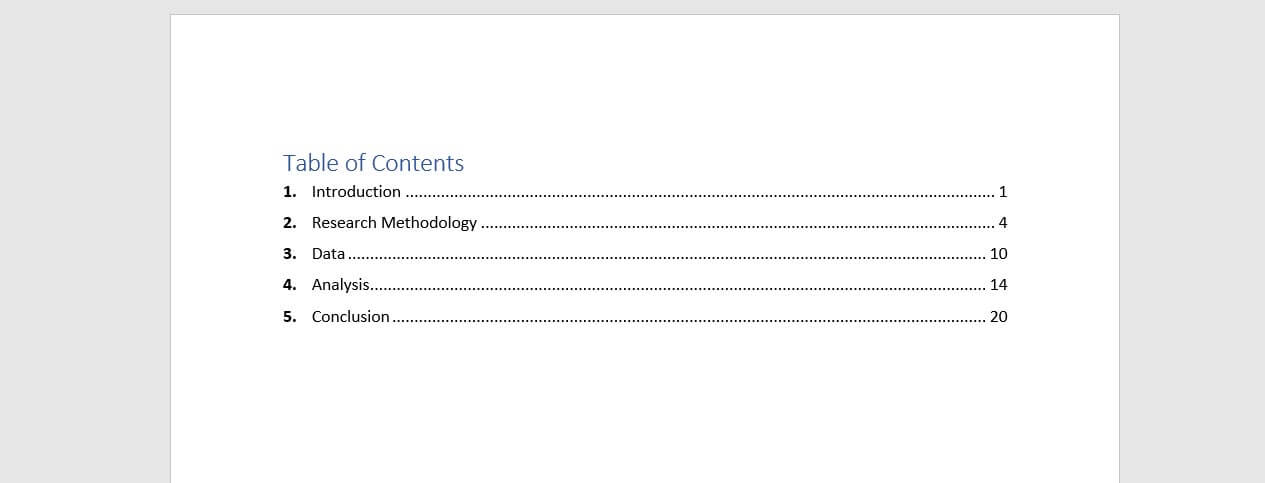
Subdivided Table of Contents E xample
A subdivided table of contents example is required for more lengthy papers, offering a subdivision of chapters and sections within chapters. These are more detailed and are recommended for higher-level dissertations like masters or PhD thesis’ (as well as some more detailed bachelor’s dissertations).
When formating subdivided table of contents example, ensure that chapters are listed in bold font and that subsections are not. It’s common (though not necessary) to denote each subsection by a number (1.1, etc.). You’ll also want to indent the subsections so that they can be read easily. The following table of contents example explores this structure:
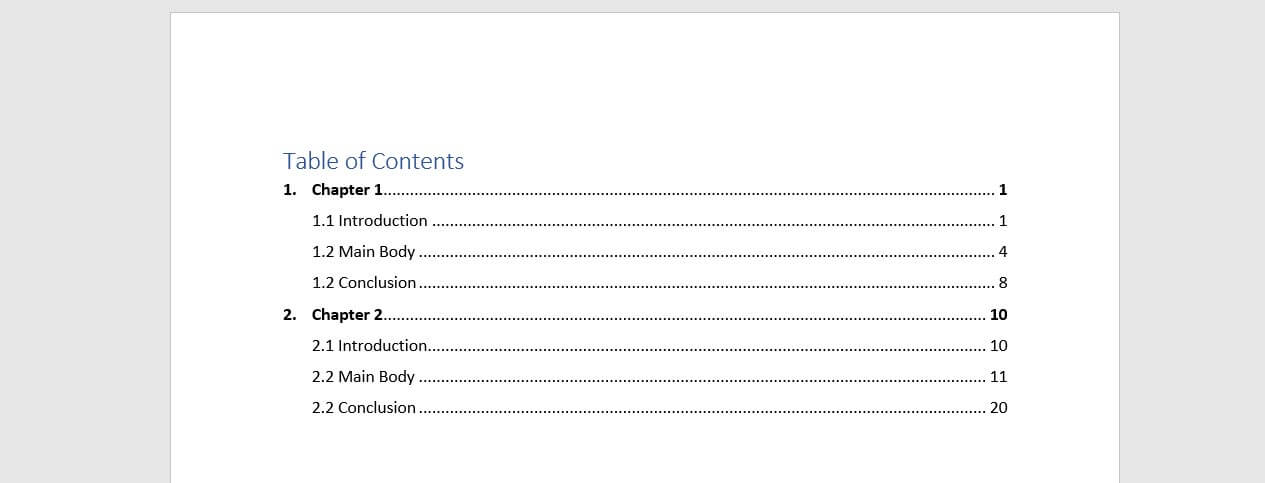
Multi-level Table of Contents E xample
Adding additional levels to your table of contents is known as a multi-level table of contents example. These would be numbered onwards at 1.1.1, etc. Be aware that although you want to guide your reader through your manuscript, you should only highlight important areas of your manuscript, like sections and sub-sections, rather than random areas or thoughts in your manuscript. Creating too many levels will make your table of contents unnecessarily busy and too complex.
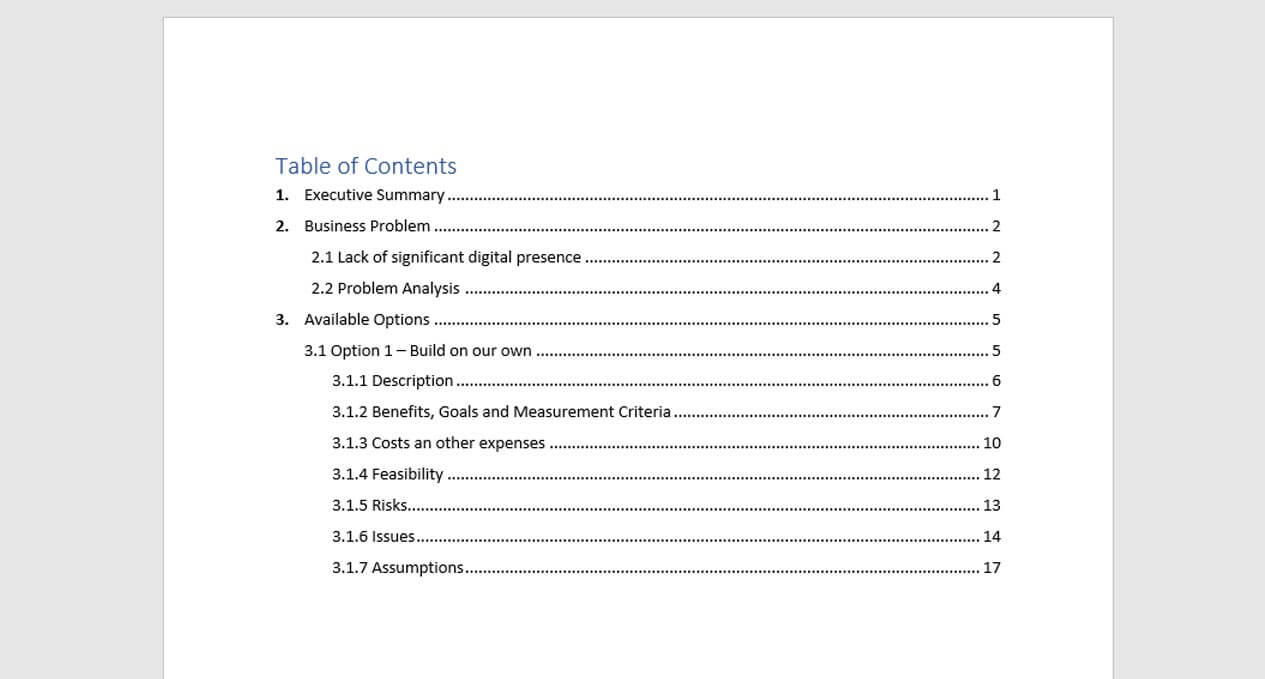
Academic Table of Contents
All of the above can be used as an academic table of contents example. Often, each separate heading in an academic work needs to be both numbered and labelled in accordance with your preferred reference style (consult your department). The following table of contents example sections will illustrate a table of contents example for a bachelor thesis and a table of contents example for a master thesis.
Table of Contents Example: Bachelor’s Thesis
A bachelor’s degree thesis has no set word or page limit nationwide and will depend entirely on your university or department’s guidelines. However, you can expect a thesis under 60 pages of length at between 10,000 – 15,000 words. As such, you won’t be expected to produce a long and detailed table of contents example with multiple levels and subsections. This is because your main body is more limited in terms of word count. At most, you may find yourself using a subdivided table of contents similar to the table of contents example above.
A bachelor’s thesis table of contents example may be structured like so:
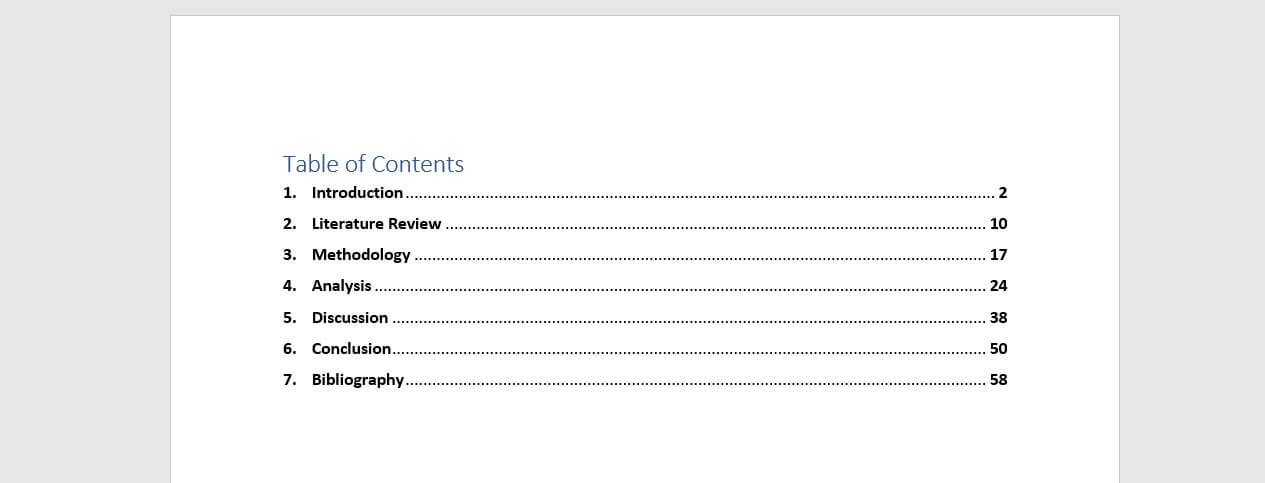
This table of contents example may change depending on your discipline and thesis structure, but note that a single-level structure will often suffice. Subdivided structures like the table of contents example listed earlier will only be necessary when writing several chapters, like in a Master’s thesis.
Master’s Thesis Examples
A master’s table of contents example is more complex than a bachelor’s thesis. This is because they average at about 80 pages with up to 40,000 words. Because this work is produced at a higher academic level, it normally includes a subdivision of chapters and subheadings, with a separate introduction and conclusion, as well as an abstract.
A table of contents example for a master’s thesis may then look something like this:
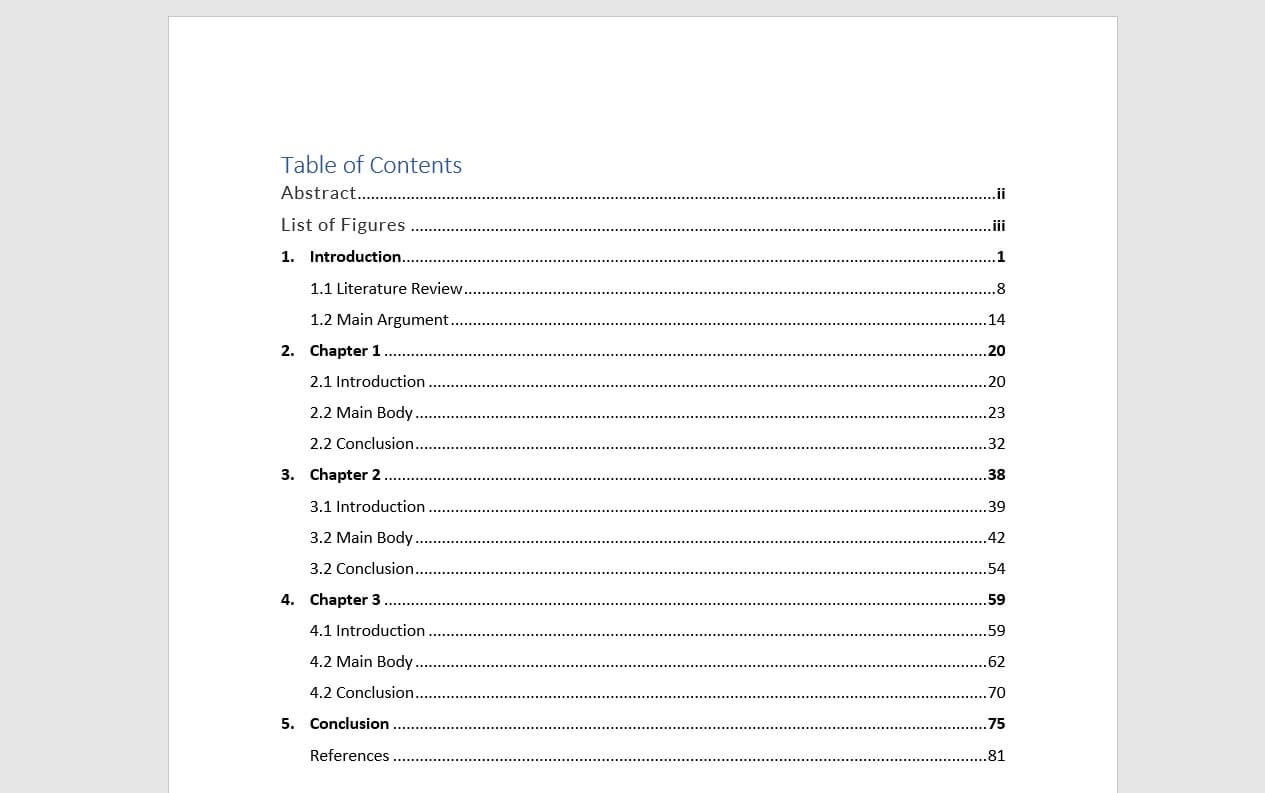
Microsoft Word Tutorial
Creating a table of contents page with Microsoft Word is simple.
In a Nutshell
- All theses are different. Various departments and disciplines follow different structures and rules. The table of contents example pages here will help you in general to format your document, but remember to consult your university guidelines
- Consistency and accuracy are the most important things to remember. You need the correct page number and the same layout for each chapter. It’s no good combining single-level table of contents with a multi-level table of contents
- Simply put, bachelor’s thesis’ generally follow a single-level table of contents example unless otherwise specified
- Postgraduate thesis’ like master and PhD-level work generally require a more detailed subdivision table of contents example. This is because they deal with both more complex arguments and more words
- Remember to include all aspects of your thesis within the table of contents. Pre-thesis material needs to be listed in Roman numerals and you need to include all back-matter as well, such as References and Bibliography
We use cookies on our website. Some of them are essential, while others help us to improve this website and your experience.
- External Media
Individual Privacy Preferences
Cookie Details Privacy Policy Imprint
Here you will find an overview of all cookies used. You can give your consent to whole categories or display further information and select certain cookies.
Accept all Save
Essential cookies enable basic functions and are necessary for the proper function of the website.
Show Cookie Information Hide Cookie Information
Statistics cookies collect information anonymously. This information helps us to understand how our visitors use our website.
Content from video platforms and social media platforms is blocked by default. If External Media cookies are accepted, access to those contents no longer requires manual consent.
Privacy Policy Imprint
- Dissertation & Thesis Guides
- Basics of Dissertation & Thesis Writing
- How to Create a Table of Contents for Dissertation, Thesis or Paper & Examples
- Speech Topics
- Basics of Essay Writing
- Essay Topics
- Other Essays
- Main Academic Essays
- Research Paper Topics
- Basics of Research Paper Writing
- Miscellaneous
- Chicago/ Turabian
- Data & Statistics
- Methodology
- Admission Writing Tips
- Admission Advice
- Other Guides
- Student Life
- Studying Tips
- Understanding Plagiarism
- Academic Writing Tips
- Essay Guides
- Research Paper Guides
- Formatting Guides
- Basics of Research Process
- Admission Guides
How to Create a Table of Contents for Dissertation, Thesis or Paper & Examples

Table of contents
Use our free Readability checker
A dissertation table of contents is a list of the chapters and sections included in a dissertation or thesis, along with their page numbers. It helps to navigate the document easily and locate specific information. Each chapter or section should be listed with its corresponding page number. The table of contents should be formatted according to the guidelines of the specific style guide being used, such as APA or MLA.
We would guess that students usually start working on the table of contents at the last minute. It is quite apparent and makes sense, as this is the list of chapters and sections with page locations. Do you think it's easy?
From our experience, it can be quite tricky to organize everything according to APA, Chicago, or any other academic writing style. In this blog, we will discuss how to write a table of contents for a research paper , thesis or dissertation in Microsoft Word. We will create it together to guide students through the process.
Also, here you will find examples of table of contents created by thesis writers at StudyCrumb . Let’s go!
What Is a Table of Contents: Definition
It is obvious that the table of contents (TOC) is an essential manuscript part you can’t skip. If you are dealing with a dissertation, thesis or research paper, you need to know how to build it in accordance with academic guidance. This is a detailed roadmap for your work and outlined structure you can follow for a research presentation.
In case you are working on an essay or report, you may not include the table of contents, as it is a short academic text. But for the research paper, thesis or dissertation, table of contents is essential and required. It is possible to say the same about any Master’s project. It should be located between the dissertation abstract and introduction chapter. In most cases, it is about 2-3 pages long.
Our expert dissertation writing service prepared a great template that can be used for your work. Make your research formatting easy with ready solutions!
Types of Table of Contents
How to choose which table of contents will fit your research paper, thesis, dissertation, or report best? Make a decision based on your work length. Some academic writing styles, such as APA paper format or MLA style , have specific formatting for this list.
However, we will outline the most commonly used typology:
- Single-level table of contents. At this type, we use only chapters. For instance, you will have an Introduction, Literature Review, methodology, and other chapters with page numbers. It can be used for shorter research work. For long writing forms like manuscripts, it can be too broad, and you will need to go into details.
- Subdivided table of contents. The most frequently used form to organize the contents table. It will include not only chapters but also sections — a level 2 subheading for each part. It will help to be more specific about what to expect in each part of your research work.
- Table of contents with multiple levels. This is a more divided structure, including subheadings with a level 3 for each section. Quite often, those subheadings can be rewritten or deleted during the last editing. It is essential to keep them in the right order.
Before you decide which type will work best for you, let us share with you some examples of each formatting style.
Example of Table of Contents With a Single Level
Introduction: The Misinformation Roots ………..…… 3 Literature Review .....................................….....………… 10 Research Methodology and Design ……................. 24 Results.............................................................................. 28 Discussion ....................................................................... 32
Sometimes, you will need to put an extra emphasis on subsections. Check this layout to see how your subheadings can be organized.
Example of Table of Contents Page with Subdivided Levels
Introduction: Information War ............……………….. 3 Background…………………………………….………..…… 4 Current State ……………………………………...…...…… 5 Defining Research Questions………………………. 9 Literature Review………………………...……………..……... 11 The Roots of Information Warfare ………....… 11 Information Wars …………………………….………..… 14 Cyber Wars Research ........................................ 17
If you are working on a lengthy, complex paper, this outline will suit your project most. It will help readers navigate through your document by breaking it down into smaller, more manageable sections.
Multi-Level Table of Contents Page Example
Introduction……………………………………………….......……….… 3 Emergence of Climate Change ………..……....….….. 3 Key Activist Groups in Climate Change .............. 5 Greenpeace International ………..…………......... 9 European Climate Foundation …….……………. 10 WWF ……………………………………….……….............. 11 Significant Movements ……………….………....……… 13 Literature Review ……………………………………......…………. 15
What Sections Should Be Included in a Table of Contents?
To start with, the scientific table of contents should include all chapters and its subheading. It is important to choose the formatting that will give your readers a full overview of your work from the very beginning. However, there are other chapters that you may miss constructing the 2-pager table. So, let's look at all you need to include:
- Dissertation introduction
- Literature review
- Research methodology
- Results section
- Dissertation discussion
- Conclusion of a thesis
- Reference list. Mention a number of a page where you start listing your sources.
- Appendices. For instance, if you have a data set, table or figure, include it in your research appendix .
This is how the ideal structured dissertation or research paper table of contents will look like. Remember that it still should take 2 pages. You need to choose the best formatting style to manage its length.
Tables, Figures, and Appendices in TOC
While creating a table of contents in a research paper, thesis or dissertation, you will need to include appendices in each case you have them. However, the formatting and adding tables and figures can vary based on the number and citation style. If you have more than 3 tables or figures, you may decide to have all of them at the end of your project. So, add them to the table of contents.
Figures, graphics, and diagrams in research papers, dissertations and theses should be numbered. If you use them from another source, ensure that you make a proper citation based on the chosen style guide.
Appendix in Table of Contents Example
Appendix A. Row Data Set…………………………………… 41 Appendix B. IBR Data………………………………………….… 43 Appendix C. SPSS Data………………………………………… 44
What Shouldn't Be Included in a Table of Contents?
When creating a dissertation table of contents, students want to include everything they have in a document. However, some components should not be on this page. Here is what we are talking about:
- Thesis acknowledgement
- Paper abstract
- The content list itself
Acknowledgement and abstract should be located before the content list, so there is no need to add them. You need to present a clear structure that will help your readers to navigate through the work and quickly find any requested information.
How to Create a Table of Contents for a Research Paper or Dissertation In Word?
It may look like working with this list can take a long. But we have one proposal for our users. Instead of writing a table of contents manually, create it automatically in Microsoft Word. You do not need any specific tech knowledge to do this. Let’s go through this process step-by-step and explain how to make a table of contents for a research paper or dissertation in a few clicks.
- Open Home tab and choose the style for your table of contents (ToC next).
- Apply heading 1 to your chapters, heading 2 to the subheading, and if needed heading 3 to the level 3 heading.
- Next, you are going to create a research paper or PhD dissertation table of contents. Open References and choose ToC.
- Choose the citation style for your work. For example, let’s choose APL for now. Meeting all style requirements (bold font, title formatting, numbers) is essential.
- Define the number of levels for your dissertation or thesis table of contents. In case you want to have 3 levels, choose Automatic Table 2.
- You are done! Click ok, and here is your page with listed chapters!
You see how easy it can be! Every time you make changes to your text or headings, it will be automatic.
Updating Your Table of Contents in MS Word
Table of contents of a research paper or dissertation is created, and you continue to edit your work until submission. It is common practice, and with MS Word, you can automate all the updates.
Let’s outline this process in our step-by-step guide!
- Right-click on your ToC in a document.
- Update field section is next.
- Choose “update ToC."
- Here, you can update your entire ToC — choose an option that works the best for you!
As you may see, working with automated solutions is much easier when you write a dissertation which has manifold subsections. That is why it is better to learn how to work on MS Word with the content list meaning be able to manage it effectively.
Table of Contents Examples
From our experience, students used to think that the content list was quite a complicated part of the work. Even with automated solutions, you must be clear about what to include and how to organize formatting. To solve the problem and answer all your questions, use our research paper or dissertation contents page example. Our paper writers designed a sample table of contents to illustrate the best practices and various styles in formatting the work.
Check our samples to find advanced options for organizing your own list.
Example of Table of Contents in Research Paper

As you can see, this contents page includes sections with different levels.
Thesis/Dissertation Table of Contents Example

Have a question about your specific case? Check samples first, as we are sure you can get almost all the answers in our guides and sample sets.
>> Read more: APA Format Table of Contents
Tips on Creating a Table of Contents
To finalize all that we shared on creating the table of contents page, let’s go through our tips list. We outline the best advice to help you with a dissertation table of contents.
- Use automated solutions for creating a list of chapters for your report, research papers, or dissertations — it will save you time in the future.
- Be clear with the formatting style you use for the research.
- Choose the best level type of list based on the paper length.
- Update a list after making changes to the text.
- Check the page list before submitting the work.
Bottom Line on Making Table of Contents for Dissertations/ Papers
To summarize, working with a research paper, thesis or dissertation table of contents can be challenging. This article outlines how to create a table of contents in Word and how to update it appropriately. You can learn what to include in the content list, how long it can be, and where to locate it. Write your work using more than one table of contents sample we prepared for students. It is often easy to check how the same list was made for other dissertations before finalizing yours. We encourage you to learn how to create a list with pages automatically and update it. It will definitely make your academic life easier.
Not sure if your work 's quality level is enough for getting a top-notch result? We’ve got you covered! Our team of skilled academic writers is always ready to help once you ask “ write my dissertation for me !" Just select your writer, send them your requirements and get a custom study tailored to your instructions.

Joe Eckel is an expert on Dissertations writing. He makes sure that each student gets precious insights on composing A-grade academic writing.
You may also like

Numbers, Facts and Trends Shaping Your World
Read our research on:
Full Topic List
Regions & Countries
- Publications
- Our Methods
- Short Reads
- Tools & Resources
Read Our Research On:
Discrimination Experiences Shape Most Asian Americans’ Lives
3. asian americans and the ‘model minority’ stereotype, table of contents.
- Key findings from the survey
- Most Asian Americans have been treated as foreigners in some way, no matter where they were born
- Most Asian Americans have been subjected to ‘model minority’ stereotypes, but many haven’t heard of the term
- Experiences with other daily and race-based discrimination incidents
- In their own words: Key findings from qualitative research on Asian Americans and discrimination experiences
- Discrimination in interpersonal encounters with strangers
- Racial discrimination at security checkpoints
- Encounters with police because of race or ethnicity
- Racial discrimination in the workplace
- Quality of service in restaurants and stores
- Discrimination in neighborhoods
- Experiences with name mispronunciation
- Discrimination experiences of being treated as foreigners
- In their own words: How Asian Americans would react if their friend was told to ‘go back to their home country’
- Awareness of the term ‘model minority’
- Views of the term ‘model minority’
- How knowledge of Asian American history impacts awareness and views of the ‘model minority’ label
- Most Asian Americans have experienced ‘model minority’ stereotypes
- In their own words: Asian Americans’ experiences with the ‘model minority’ stereotype
- Asian adults who personally know an Asian person who has been threatened or attacked since COVID-19
- In their own words: Asian Americans’ experiences with discrimination during the COVID-19 pandemic
- Experiences with talking about racial discrimination while growing up
- Is enough attention being paid to anti-Asian racism in the U.S.?
- Acknowledgments
- Sample design
- Data collection
- Weighting and variance estimation
- Methodology: 2021 focus groups of Asian Americans
- Appendix: Supplemental tables
In the survey, we asked Asian Americans about their views and experiences with another stereotype: Asians in the U.S. being a “model minority.” Asian adults were asked about their awareness of the label “model minority,” their views on whether the term is a good or bad thing, and their experiences with being treated in ways that reflect the stereotype.
What is the ‘model minority’ stereotype?
Amid the Civil Rights Movement in the 1960s, another narrative about Asian Americans became widespread: being characterized as a “model” minority. In 1966, two articles were published in The New York Times Magazine and U.S. News and World Report that portrayed Japanese and Chinese Americans as examples of successful minorities. Additionally, in 1987 Time magazine published a cover story on “those Asian American whiz kids.” The model minority stereotype has characterized the nation’s Asian population as high-achieving economically and educationally, which has been attributed to Asians being hardworking and deferential to parental and authority figures, among other factors. The stereotype generalizes Asians in the U.S. as intelligent, well-off, and able to excel in fields such as math and science. Additionally, the model minority myth positions Asian Americans in comparison with other non-White groups such as Black and Hispanic Americans.
For many Asians living in the United States, these characterizations do not align with their lived experiences or reflect their diverse socioeconomic backgrounds . Among Asian origin groups in the U.S., there are wide differences in economic and social experiences. Additionally, academic research has investigated how the pressures of the model minority stereotype can impact Asian Americans’ mental health and academic performance . Critics of the myth have also pointed to its impact on other racial and ethnic groups, especially Black Americans. Some argue that the myth has been used to minimize racial discrimination and justify policies that overlook the historical circumstances and impacts of colonialism, slavery and segregation on other non-White racial and ethnic groups.
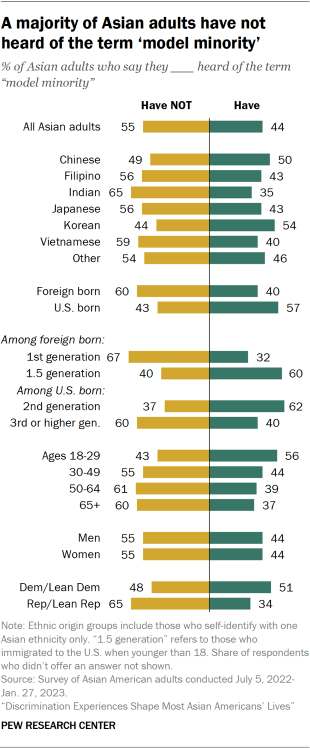
More than half of Asian adults (55%) say they have not heard of the term “model minority.” Just under half (44%) say they have heard of the term.
There are some differences in awareness of the term across demographic groups:
- Ethnic origin: About half of Korean and Chinese adults say they have heard of the term, while only about one-third of Indian adults say the same.
- Nativity: 57% of U.S.-born Asian adults have heard the term “model minority,” compared with 40% of immigrants.
- Immigrant generation: Among immigrants, 60% of those who came to the U.S. as children (“1.5 generation” in this report) say they have heard of the term “model minority,” compared with 32% of those who came to the U.S. as adults (first generation). And among U.S.-born Asian Americans, those who are second generation are more likely than those who are third or higher generation to say the same (62% vs. 40%).
- Age: 56% of Asian adults under 30 say they have heard of the term, compared with fewer than half among older Asian adults.
- Party: 51% of Asian adults who identify with or lean to the Democratic Party say they’ve heard the term, compared with 34% of those who identify with or lean to the Republican Party.
Awareness of the term ‘model minority’ varies across education and income
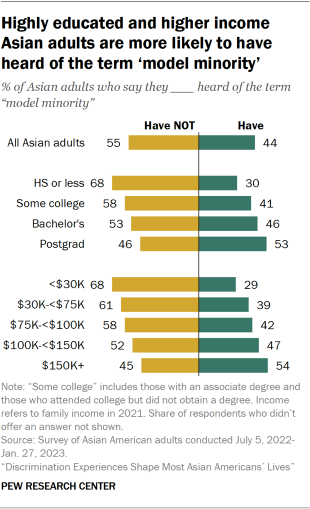
Asian adults with higher levels of formal education and higher family income are more likely to say they have heard of the term “model minority”:
- 53% of Asian adults with a postgraduate degree say they have heard the term, compared with smaller shares of those with a bachelor’s degree or less.
- 54% of Asian adults who make $150,000 or more say they have heard the term, higher than the shares among those with lower incomes. Among Asian Americans who make less than $30,000, only 29% say they have heard of the term “model minority.”
Notably, awareness of the term is higher among those born in the U.S. than immigrants across all levels of education and income.
Among Asian adults who have heard of the term “model minority,” about four-in-ten say using it to describe Asians in the U.S. is a bad thing. Another 28% say using it is neither good nor bad, 17% say using it is a good thing, and 12% say they are not sure.
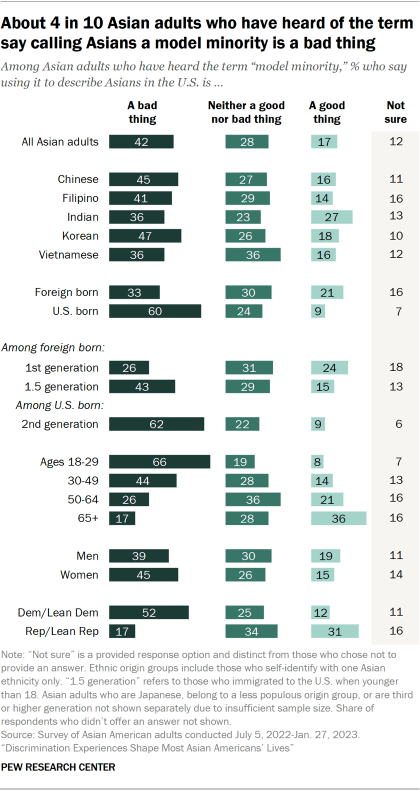
These views vary by ethnic origin, nativity, age and party. Among those who have heard of the term:
- Ethnic origin: Among Indian adults, the gap between those who say the term “model minority” is a bad thing and those who say it is a good thing (36% vs. 27%) is smaller than among other ethnic origin groups.
- Nativity: 60% of U.S.-born Asian adults say describing Asians as a model minority is a bad thing, while 9% say it is a good thing. Meanwhile, immigrants’ views of the model minority stereotype are more split (33% vs. 21%, respectively).
- Immigrant generation: Among immigrants, 43% of 1.5-generation Asian adults say using the term “model minority” is a bad thing, compared with 26% of first-generation Asian adults.
- Age: Asian adults under 30 are far more likely to say the model minority label is a bad thing than a good thing (66% vs. 8%). Meanwhile, Asian adults 65 and older are more likely to say describing Asian Americans as a model minority is a good thing (36%) than a bad thing (17%).
- Party: 52% of Asian Democrats say describing Asians as a model minority is a bad thing, about three times the share of Asian Republicans who say the same (17%).
Among those who know the term “model minority,” views of whether using it to describe Asians in the U.S. is a good or bad thing does not vary significantly across education levels. By income, Asian adults who make less than $30,000 are somewhat less likely to say it is a bad thing than those with higher incomes. 18
Views of the ‘model minority’ label are linked to perceptions of the American dream
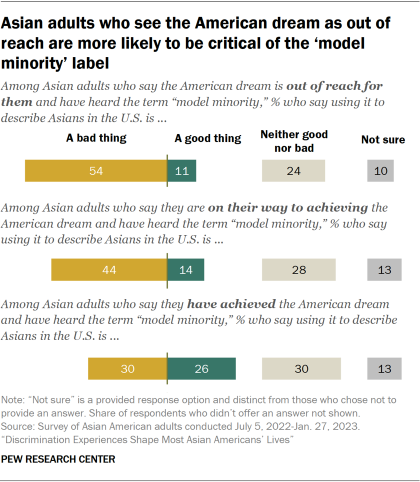
In the survey, we asked Asian Americans if they believe they have achieved the American dream, are on their way to achieving it, or if they believe the American dream is out of their reach. Among those who have heard of the term “model minority”:
- 54% of Asian adults who believe the American dream is out of their reach say describing Asian Americans as a model minority is a bad thing. This is higher than the shares among those who believe they are on their way to achieving (44%) or believe they have already achieved the American dream (30%).
- Meanwhile, 26% of Asian adults who believe they have achieved the American dream say the model minority label is a good thing. In comparison, 14% of those who believe they are on their way to achieving the American dream and 11% of those who believe that the American dream is out of their reach say the same.
In this survey, we asked Asian Americans how informed they are about the history of Asians in the U.S.
Whether Asian adults have heard of the model minority label is linked to their knowledge of Asian American history:
- 62% of Asian adults who are extremely or very informed of U.S. Asian history have heard of the term “model minority.”
- Smaller shares of those who are somewhat informed (44%) or a little or not at all informed (29%) about U.S. Asian history say they are aware of the term.
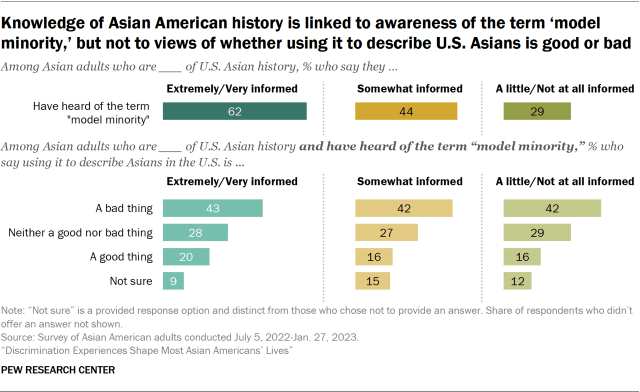
However, among those who have heard of the “model minority” label, views on whether using it to describe Asian Americans is good or bad are similar regardless of how informed they are on Asian American history. About four-in-ten across knowledge levels say describing Asian Americans as a model minority is a bad thing.
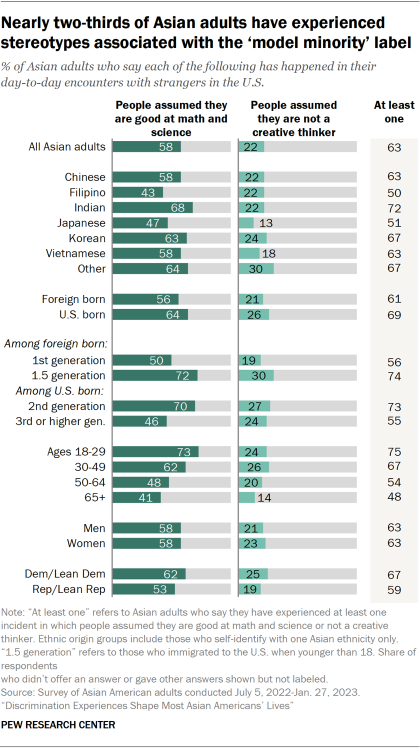
The model minority stereotype often paints Asian Americans as intellectually and financially successful, deferential to authority, and competent but robotic or unemotional , especially in comparison with other racial and ethnic groups. Additionally, some stereotypes associated with the model minority characterize Asian Americans as successful in fields such as math and science, as well as lacking in creativity.
Nearly two-thirds of Asian adults (63%) say that in their day-to-day encounters with strangers, they have at least one experience in which someone assumed they are good at math and science or not a creative thinker.
Broadly, Asian adults are far more likely to say someone has assumed they are good at math and science (58%) than not a creative thinker (22%).
Across these experiences, there are some differences by demographic groups:
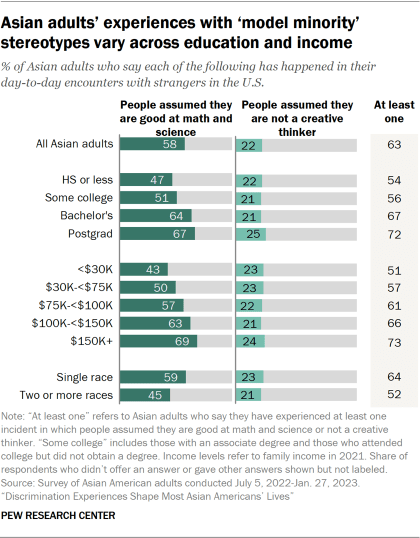
- Ethnic origin: 68% of Indian adults say strangers have assumed they are good at math and science, a higher share than among most other origin groups. Meanwhile, about half or fewer of Japanese (47%) and Filipino (43%) adults say people have made this assumption about them.
- Immigrant generation: About seven-in-ten Asian adults who are 1.5 generation and second generation each say people have assumed they are good at math and science, compared with 50% among the first generation and 46% among third or higher generations.
- Education: About two-thirds of Asian adults with a postgraduate degree or a bachelor’s degree say strangers have assumed they are good at math and science, compared with roughly half of those with some college experience or less. Similar shares regardless of education say people have assumed they are not a creative thinker.
- Income: 69% of those who make $150,000 or more say strangers have assumed they are good at math and science, compared with 43% of those who make less than $30,000.
- Race: 59% of single-race Asian adults (those who identify as Asian and no other race) say someone assumed they are good at math and science, compared with 45% of Asian adults who identify with two or more races (those who identify as Asian and at least one other race).
In our 2021 focus groups of Asian Americans, participants talked about their views of and experiences with the “model minority” stereotype.
Many U.S.-born Asian participants shared how it has been harmful , with some discussing the social pressures associated with it. Others spoke about how the stereotype portrays Asians as monolithic and compares them with other racial and ethnic groups.
“You have to be polished. There’s no room for failure. There’s no room for imperfections. You have to be well-spoken, well-educated, have the right opinions, be good-looking, be tall. [You] have to have a family structure. There’s no room for any sort of freedom in identity except for the mold that you’ve been painted as – as a model citizen.”
–U.S.-born man of Pakistani origin in early 30s
“As an Asian person, I feel like there’s a stereotype that Asian students are high achievers academically. They’re good at math and science. … I was a pretty mediocre student, and math and science were actually my weakest subjects, so I feel like it’s either way you lose. Teachers expect you to fit a certain stereotype and if you’re not, then you’re a disappointment, but at the same time, even if you are good at math and science, that just means that you’re fitting a stereotype. It’s [actually] your own achievement, but your teachers might think ‘Oh, it’s because they’re Asian,’ and that diminishes your achievement.”
–U.S.-born woman of Korean origin in late 20s
“The model minority myth … mak[es] us as Asians [and] South Asians monoliths. … I’ve had people go, ‘Oh, so your dad’s a doctor? Is he a lawyer? Do you have money? Do you have this? Do you have that? Are you [in] an arranged marriage?’ And just the kind of image that portrays and gives us. But the expectations put on us as being high performing and everyone assumes you’re going to be smart. … I am a black sheep in many ways, not only within my family, but within Asian [and] South Asian culture, being [in my profession], someone who’s not a doctor, who hasn’t gone the professional, traditional, educational route. So, it’s very harmful, that too, for those communities within the Asian diaspora who have come to the United States. … [M]any of them come from impoverished and underrepresented communities and the expectations put on them to produce or the types of jobs and menial labor they have to take on as a result is really a very poisonous mythos to have out there.”
–U.S.-born woman of Indian origin in early 40s
“One of the reasons the model minority fallacy works so well as an argument against affirmative action [for Indians is] they are a newer immigrant group that has come here and … [t]here’s a lot of education [in India]. People have opportunity there that then they can come [to America] and continue with those connections. Whereas Blacks and Hispanics have had generations of oppression, so they don’t have anything to build off of. So when you bucket everybody – Black, Hispanics and Asians – into one group, then you can make those arguments of, ‘Oh, [Asians] are the model minority, they can do it.’”
Some participants talked about having mixed feelings about being called the “model minority” and how they felt like it put them in a kind of “middle ground.”
“I feel like Asians are kind of known as the model minority. That kind of puts us in an interesting position where I feel like we’re supposed to excel and succeed in the media, or we’re seen in the media as exceeding in all these things as smart. All of us are not by any means. Yeah, I feel like we’re in this weird middle ground.”
–U.S.-born man of Chinese origin in early 20s
“A lot of people believe that Japanese are the most humble and honest people, even among other Asians. I feel like I need to live up to that. I have to try hard when people say things like that. Of course, it is good, but it’s a lot of work sometimes. As Japanese, and for my family, I try hard.”
–Immigrant man of Japanese origin in mid-40s (translated from Japanese)
Others had more positive impressions of the model minority label, saying it made them proud to be Asian and have others see them that way:
“Whenever I apply for any job, in the drop-down there is an option to choose the ethnicity, and I write Asian American proudly because everyone knows us Asians as hardworking, they recognize us as loyal and hardworking.”
–Immigrant woman of Nepalese origin in mid-40s (translated from Nepali)
“I think any model is a good thing. I mean the cognitive, the word ‘model,’ when you model after somebody it’s a positive meaning to it. So personally for me I have no issues with being called the model minority because it only tells me that I’m doing something right.”
–U.S.-born man of Hmong origin in early 40s
- Some of these groups had relatively small sample sizes. For shares of Asian adults who have heard of the term “model minority” and say using the term to describe the U.S. Asian population is a good or bad thing, by education and income, refer to the Appendix . ↩
Sign up for our weekly newsletter
Fresh data delivery Saturday mornings
Sign up for The Briefing
Weekly updates on the world of news & information
- Asian Americans
- Discrimination & Prejudice
- Immigration Issues
- Race Relations
- Racial Bias & Discrimination
Key facts about Asian Americans living in poverty
Methodology: 2023 focus groups of asian americans, 1 in 10: redefining the asian american dream (short film), the hardships and dreams of asian americans living in poverty, key facts about asian american eligible voters in 2024, most popular, report materials.
1615 L St. NW, Suite 800 Washington, DC 20036 USA (+1) 202-419-4300 | Main (+1) 202-857-8562 | Fax (+1) 202-419-4372 | Media Inquiries
Research Topics
- Age & Generations
- Coronavirus (COVID-19)
- Economy & Work
- Family & Relationships
- Gender & LGBTQ
- Immigration & Migration
- International Affairs
- Internet & Technology
- Methodological Research
- News Habits & Media
- Non-U.S. Governments
- Other Topics
- Politics & Policy
- Race & Ethnicity
- Email Newsletters
ABOUT PEW RESEARCH CENTER Pew Research Center is a nonpartisan fact tank that informs the public about the issues, attitudes and trends shaping the world. It conducts public opinion polling, demographic research, media content analysis and other empirical social science research. Pew Research Center does not take policy positions. It is a subsidiary of The Pew Charitable Trusts .
Copyright 2024 Pew Research Center
Terms & Conditions
Privacy Policy
Cookie Settings
Reprints, Permissions & Use Policy

IMAGES
VIDEO
COMMENTS
Generating the table of contents. Now you can generate your table of contents. First write the title "Contents" (in the style of a level 1 heading). Then place your cursor two lines below this and go to the References tab. Click on Table of Contents and select Custom Table of Contents…. In the popup window, select how many levels of ...
In Microsoft Word, go to the References tab, click on Table of Contents, and choose a style from the list. The table of contents will be inserted into your document. Update the table of contents: If you make changes to your document, such as adding or deleting sections, you'll need to update the table of contents. In Microsoft Word, right ...
However, a typical term paper usually consists of the following sections: Title page: This should include the title of your paper, your name, the course name and number, your instructor's name, and the date. Abstract: This is a brief summary of your paper, usually no more than 250 words. It should provide an overview of your topic, the ...
Now you need to format your headings to be included in the table of contents. Select the heading you want to include in your table of contents. Click on the "Styles" option in the top menu bar. Choose the appropriate heading style from the drop-down menu that appears. You can choose from "Heading 1," "Heading 2," "Heading 3," etc.
Here's how to refine your work efficiently: Take a Break: Step back and return to your paper with a fresh perspective. Structure Check: Ensure your paper flows logically and transitions smoothly from the introduction to the conclusion. Clarity and Conciseness: Trim excess words for clarity and precision.
To summarize, the following steps will help you create a clear and concise table of contents to guide readers through your research paper: 1. Insert the table of contents after the title page. 2. List all the sections and subsections in chronological order. 3. Paginate each section. 4. Format the table of contents according to your style guide. 5.
Dissertation Table of Contents in Word | Instructions & Examples. Published on May 15, 2022 by Tegan George.Revised on July 18, 2023. The table of contents is where you list the chapters and major sections of your thesis, dissertation, or research paper, alongside their page numbers.A clear and well-formatted table of contents is essential, as it demonstrates to your reader that a quality ...
Table of contents. Once you've started your university career, you are going to be asked to present a term paper. ... Link: Term Paper Sample: Consumer Buying Behavior. The Do's and Don'ts of Term Paper Writing. Do's: Don'ts: Write down every idea you have, even if there's no structure to them. Just record any phrases, tips, quotes ...
The table of contents forms an essential part of any academic paper. Through the use of headings, sub-headings, and page numbers, we can construct an accurate road map to assist reviewers, evaluators, tutors, and general readers. The table of contents shows how effective the writer is at dividing the thesis into relevant and manageable sections.
Hence, an example of a Table of Contents written in the APA format is indicated below: How to Write a Table of Contents in MLA. Unlike papers written in the APA style, MLA papers do not require a Table of Contents unless they are long enough. In this case, documents, like theses, dissertations, and books written in the MLA format should have a TOC.
Step 4: Click the arrow that is next to the TOC icon and select Custom Table of Contents. Here, select the level of heading that you would like to include in your table and also make the necessary adjustments to each level by clicking the modify button. Click on Custom table of contents.
A table of contents is a list, usually on a page at the beginning of a piece of academic writing, which outlines the chapters or sections names with their corresponding page numbers. In addition to chapter names, it includes bullet points of the sub-chapter headings or subsection headings. It usually comes right after the title page of a ...
Make a table with two columns. Then, place the headings and subheadings in the first column in order. Put the applicable page numbers in the second column. Check that the subheadings are located underneath the correct headings, indented to the right. Make sure there are page numbers for the subheadings listed as well.
Take care of 1 "padding on all sides of the sheet. Add your last name and page number to all pages in the upper right corner. Align the title of the article in the center. Don't use bold, italic, quotation marks, underlines, etc.
Below, you will find different examples for table of contents, including a. Single level table of contents example. Subdivided table of contents example. Multi-level table of contents example. We will also show you with an example how the table of contents for a bachelor's thesis could look like, as well as for a master's thesis.
Reviewing a solid table of contents example can help you understand this important feature. See examples to help you create your own table of contents.
MS Word is equally as useful, but creating a table of contents in Google Docs is a really straightforward process. Choose your preferred location for your table of contents on the document. Click 'Insert' and choose 'Table of contents.'. Decide on your chosen table of contents format.
Learn the table of contents format and definition, what a table of contents looks like, examples, and how to add a table of contents to different mediums. Updated: 11/21/2023 Table of Contents
Open Home tab and choose the style for your table of contents (ToC next). Apply heading 1 to your chapters, heading 2 to the subheading, and if needed heading 3 to the level 3 heading. Next, you are going to create a research paper or PhD dissertation table of contents. Open References and choose ToC.
Consider using index cards or separate pieces of paper, or creating notes on the computer so you can easily organize all your notes. Organize your notes so that they flow logically. Pay attention to correct writing elements such as grammar, spelling, effective phrasing of ideas, and good paragraph development. Have someone else read through ...
Category #5: Table of Contents for White Papers. The difference between an eBook and a brand is the audience. The former includes easily skimmable information for non-experts, while the latter is mostly an in-depth report of expert information relayed to professionals in a certain field. ... Keep scrolling to browse table of contents examples ...
Immigrant generation: Among immigrants, 43% of 1.5-generation Asian adults say using the term "model minority" is a bad thing, compared with 26% of first-generation Asian adults. Age: Asian adults under 30 are far more likely to say the model minority label is a bad thing than a good thing (66% vs. 8%).